Over the last 25 years, advancements in field research, bioacoustics, and genetic analysis have significantly enhanced our ability to identify and classify new bird species. Since 2000, ornithologists have documented a remarkable number of previously unrecognized species, expanding our understanding of avian biodiversity across diverse ecosystems, from isolated mountain ranges and dense rainforests to understudied river basins. These discoveries not only reveal the complexity of global bird populations but also highlight the urgent need for conservation in the face of habitat loss and environmental change.
Note: In this report, the discovery year refers to the year a species was formally recognized and described in scientific literature. However, many species were first observed, collected, or suspected to be distinct years (or even decades) earlier. When available, we include details on the first recorded observation or field encounters that preceded the species’ formal description.
Jump to a specific year:
- Birds discovered in 2024
- Birds discovered in 2022
- Birds discovered in 2006
- Birds discovered in 2005
- Birds discovered in 2004
- Birds discovered in 2003
- Birds discovered in 2002
- Birds discovered in 2001
- Birds discovered in 2000
Bird species discovered and recognized in 2024:
Northern giant hummingbird (Patagona peruviana)
- Discovered: 2024.
- Location: High Andes, South America.
- Discovered by: J. L. Williamson, E. F. Gyllenhaal, S. M. Bauernfeind, and C. C. Witt.

The northern giant hummingbird was long considered a subspecies of the giant hummingbird (Patagona gigas), but genomic research in 2024 confirmed it as a distinct species. Dr. Jessie L. Williamson and her team conducted genetic analyses and tracking studies, revealing that the northern and southern populations diverged between 2.1 and 3.4 million years ago. While nearly identical in appearance, the two species differ in migration and physiology – P. peruviana remains year-round at high altitudes, while P. gigas undertakes extreme elevational migrations.
This species is the largest hummingbird in the world, weighing 17 to 31 grams (0.6-1.1 oz), nearly twice the size of any other hummingbird. It has specialized adaptations for high-altitude survival, including enlarged lungs and increased blood oxygen capacity. Initially proposed as Patagona chaski, the name was invalidated as the species had already been described by Adolphe Boucard in 1893. Conservation concerns remain uncertain, but climate change and habitat degradation could impact its specialized ecosystem.
Timor nightjar (Caprimulgus ritae)
- Discovered: 2024.
- Location: Timor and Wetar, Lesser Sunda Islands, Wallacea.
- Recognized by: B. F. King, G. Sangster, C. R. Trainor, M. Irestedt, D. M. Prawiradilaga, and P. G. P. Ericson.
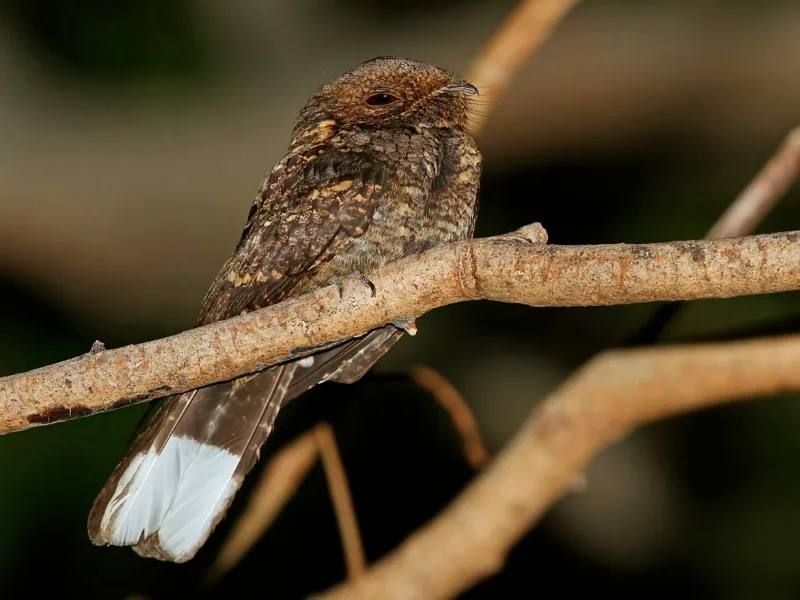
The Timor nightjar was previously confused with large-tailed nightjar (Caprimulgus macrurus), Philippine nightjar (C. manillensis), and Sulawesi nightjar (C. celebensis), but a taxonomic study in 2024 by Dr. Ben F. King and colleagues confirmed it as a separate species. It was identified based on morphological, genetic, and vocal differences. The species is the smallest in the Caprimulgus macrurus complex, with distinct territorial songs differing in at least 13 vocal characters. It also differs morphologically from its closest relatives, with shorter wings, tail, and different plumage patterns. Phylogenetic analysis revealed that C. ritae is most closely related to Mees’s nightjar (C. meesi), with which it forms a sister clade to C. macrurus.
This nightjar inhabits lowland and montane tropical forests from sea level to at least 1,500 meters, though it likely occurs mostly below 1,000 meters. Its habitat is under increasing pressure from deforestation and development, particularly on Timor, where forest cover is declining. Wetar, however, remains relatively intact, with over 95% of its natural vegetation preserved, dominated by Eucalyptus woodlands and riverine tropical forests. Despite its recent recognition, C. ritae may already be at risk due to ongoing habitat loss, highlighting the need for further conservation assessments.
Northern silvery-cheeked antshrike (Sakesphoroides niedeguidonae)
- Discovered: 2024.
- Location: Caatinga biome, northeastern Brazil.
- Recognized by: P. Cerqueira, G. R. Goncalves, T. F. Quaresma, M. Silva, M. Pichorim, and A. Aleixo.
The northern silvery-cheeked antshrike was identified as a distinct species in 2024 by Dr. Pablo Cerqueira and colleagues through genetic, vocal, and plumage analyses. Previously considered part of the silvery-cheeked Antshrike (Sakesphoroides cristatus), it was found to have unique morphological and acoustic traits. Males closely resemble S. cristatus, but females have a lighter amber crown, olive-brown back, and a black-and-white barred tail, which contrasts with the more uniformly rufous-brown tail of S. cristatus.
This species inhabits the dry forests of the Caatinga, a biome long underestimated in terms of biodiversity. Genetic studies indicate that S. niedeguidonae and S. cristatus diverged approximately 1.2 million years ago, with historical climate shifts shaping their populations. Although its conservation status has yet to be evaluated, ongoing habitat loss due to deforestation and climate change may pose risks to its long-term survival.
Andean black-goggled tanager (Trichothraupis griseonota)
- Discovered: 2024.
- Location: Eastern slopes of the Andes (Peru, Bolivia, northwestern Argentina).
- Discovered by: V. Cavarzere, T. V. V. Costa, G. S. Cabanne, N. Trujillo-Arias, R. S. Marcondes, and L. F. Silveira.
The Andean black-goggled tanager was previously classified as a population of the widespread black-goggled tanager (Trichothraupis melanops), but a taxonomic revision in 2024 by Vagner Cavarzere and colleagues confirmed it as a separate species. Morphological and genetic analyses revealed that the Andean population differs significantly in plumage and genetic markers from its Atlantic Forest counterpart. The new species has a darker facial mask covering the auricular region, a greyer back instead of olive, and paler underparts, with notable differences in tarsus length.
The recognition of T. griseonota highlights the role of museum specimens in species discovery, as researchers first noticed these differences while examining preserved skins in natural history collections. Despite being newly recognized, the species’ habitat is already affected by deforestation and climate change, making conservation assessments necessary to determine its vulnerability.
Bird species discovered and recognized in 2022:
Subantarctic rayadito (Aphrastura subantarctica)
- Discovered: 2022.
- Location: Diego Ramirez Archipelago, Chile.
- Discovered by: R. Rozzi, C. S. Quilodran, E. Botero-Delgadillo, and team.
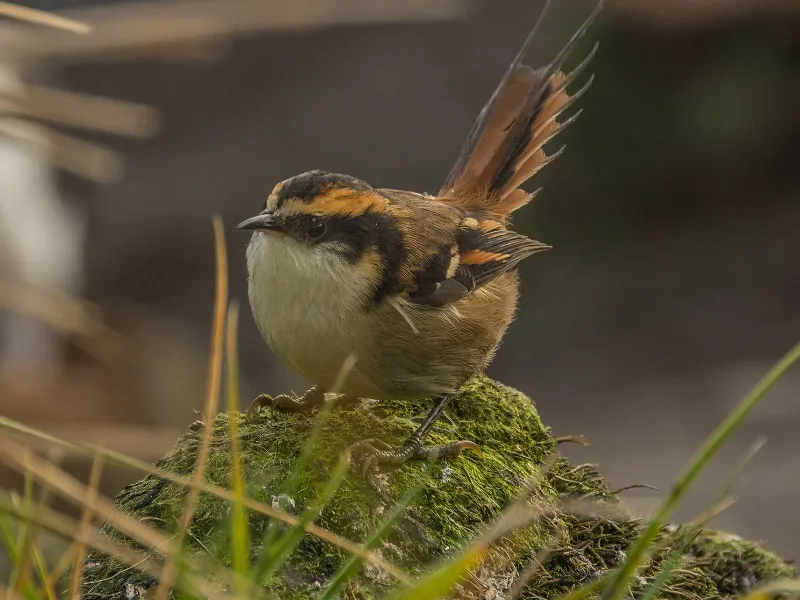
The subantarctic rayadito was described as a distinct species in 2022, following extensive research led by Dr. Ricardo Rozzi, head of the Cape Horn International Center and a key figure in subantarctic biocultural conservation. Initially thought to be a population of thorn-tailed rayadito (Aphrastura spinicauda), these birds exhibit notable morphological, genetic, and behavioral differences. Compared to their mainland relatives, subantarctic rayaditos have larger beaks, longer tarsi, shorter tails, and greater body mass. Their behavior is also distinct, as they forage at lower heights and nest in cavities in the ground rather than in trees, adapting to an environment devoid of woody vegetation.
Genetic analysis confirmed that this population is isolated from gene flow with its continental relatives, warranting classification as a new species. It is endemic to the Diego Ramírez Archipelago, a pristine subantarctic ecosystem protected within the Diego Ramírez Islands-Drake Passage Marine Park. The species’ restricted range and small population make it potentially vulnerable to habitat disturbances and the introduction of invasive predators, emphasizing the need for long-term monitoring and conservation.
Principe scops owl (Otus bikegila)
- Discovered: 2022.
- Location: Principe Island, Sao Tome and Principe.
- Discovered by: M, Melo, B. Freitas, P. Verbelen, S. R. da Costa, and team.
- Current status: Critically Endangered.
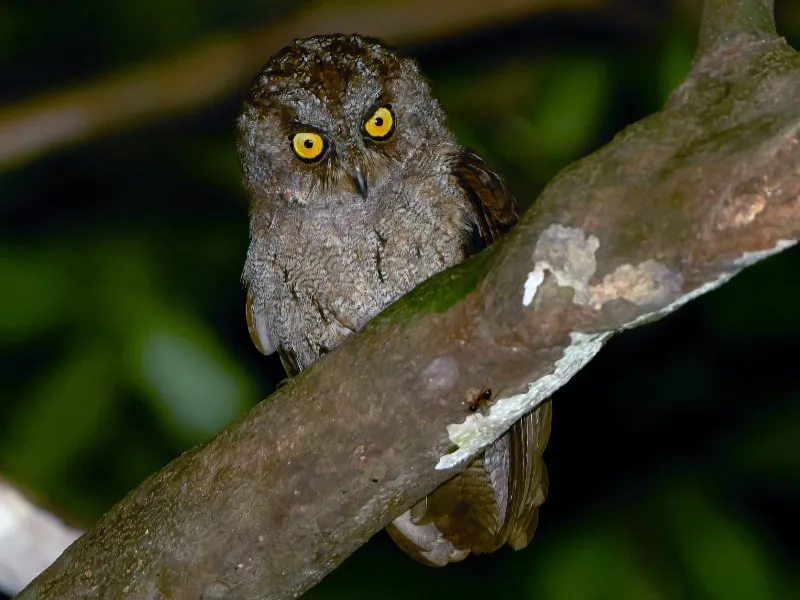
The Príncipe scops owl was scientifically described in 2022, following years of accumulating evidence pointing to its existence. Although reports from local residents date back to 1928, it wasn’t formally recognized until 2016, when its presence in the old-growth native forests of Príncipe Island was confirmed. The species was discovered by a team led by ornithologist Martim Melo, with the description based on morphological, vocalization, and genetic data. Notably, its distinct call was instrumental in its identification, as it differs significantly from related species. Genetic analysis suggests it descended from an early colonization of the Gulf of Guinea islands, making it closely related to the Sao Tome scops owl (Otus hartlaubi) and the Pemba scops owl (Otus pembaensis).
Endemic to Principe Obo Natural Park, this owl is one of the most range-restricted in the world, with an estimated population of 800-1,600 mature individuals. While the island is a UNESCO Biosphere Reserve, habitat loss remains a concern due to logging, infrastructure development, and a proposed hydroelectric dam. The Mona monkey, known to raid nests of other endangered species, may pose a risk, along with potential predation from black rats, feral cats, and African civets. Competition for nesting sites with the grey parrot (Psittacus erithacus) is also possible, though its impact is unclear. Protecting its forest habitat and monitoring introduced species will be key to its conservation.
Wangi-wangi white-eye (Zosterops paruhbesar)
- Discovered: 2022.
- Location: Wangi-wangi Island, Wakatobi Islands, Southeast Sulawesi, Indonesia.
- Discovered by: M. Irham, D. M. Prawiradilaga, J. K. Menner, D. P. O’Connell, and team.
- Current status: Endangered.
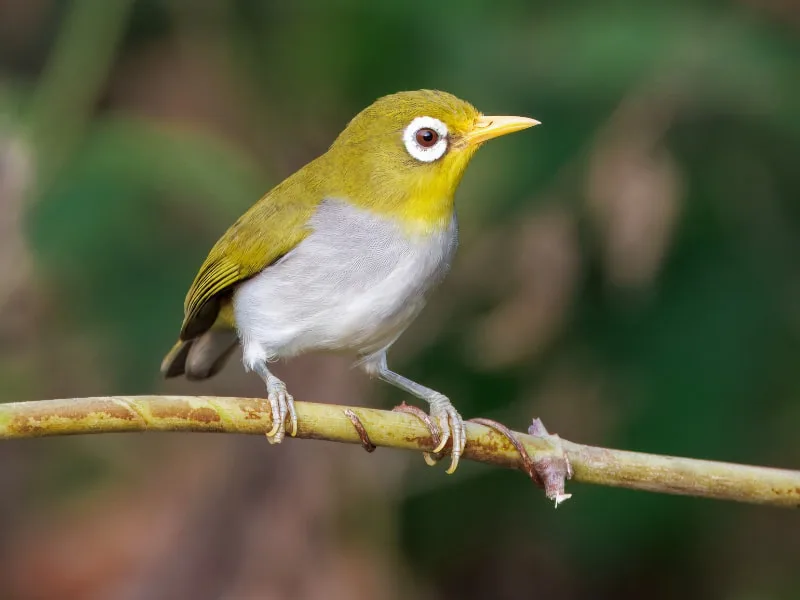
The Wangi-wangi white-eye was officially described in 2022 by a team led by Mohammad Irham, making it one of Indonesia’s newest scientifically recognized bird species. Endemic to Wangi-wangi Island, it is larger than most white-eyes, with a distinctive orange-yellow bill that sets it apart from the Wakatobi white-eye (Zosterops flavissimus), the only other Zosterops species in its range. The species inhabits tall forests, secondary woodlands, and plantations with emergent trees, where it forages for fruit and nectar. Despite being described as locally common in early observations, recent surveys suggest it is becoming increasingly rare.
With an estimated 500-1,500 mature individuals, the species faces habitat loss and trapping for the songbird trade. Deforestation for timber and tourism infrastructure has reduced its available habitat, and trapping has intensified since its discovery, with birds appearing in local markets. While its entire range falls within Wakatobi National Park, the level of protection remains uncertain. A captive breeding program at Prigen Conservation Breeding Ark (PCBA) now holds 23 individuals, but urgent conservation actions are needed to monitor population trends, curb trapping, and protect its remaining habitat.
Bird species discovered and recognized in 2006:
Yariguies brush finch (Atlapetes latinuchus yariguierum)
- Discovered: 2006.
- Location: Serranía de los Yariguíes, Colombia.
- Discovered by: Thomas M. Donegan and Blanca Huertas.
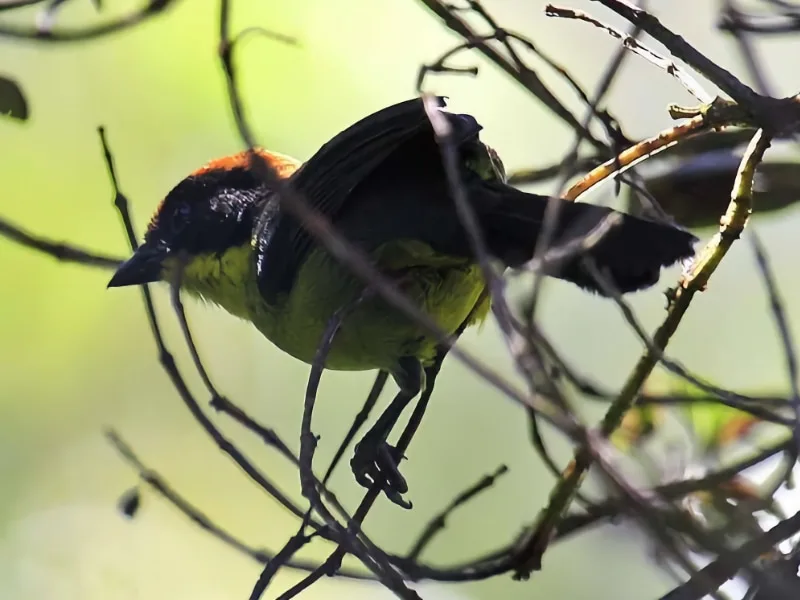
The Yariguies brush finch was first discovered in 2005 during an expedition led by Thomas M. Donegan and Blanca Huertas in the previously unexplored Serranía de los Yariguíes. It was formally described in 2006 after analysis confirmed its distinctiveness from other members of the Atlapetes latinuchus complex. This brush finch has a yellow breast, black back, wings, and tail, with a rufous crown. It differs from related species by lacking white wing markings. The finch inhabits montane cloud forests above 3,000 meters, an environment characterized by high humidity and dense vegetation.
Although not individually assessed by the IUCN, its habitat is within a protected national park established in 2005, shortly after its discovery. While this designation helps safeguard the species, its restricted range and specialized habitat warrant continued monitoring to evaluate conservation needs.
Bugun liocichla (Liocichla bugunorum)
- Discovered: 2006.
- Location: Eaglenest Wildlife Sanctuary, Arunachal Pradesh, India.
- Discovered by: Ramana Athreya.
- Current status: Critically Endangered.
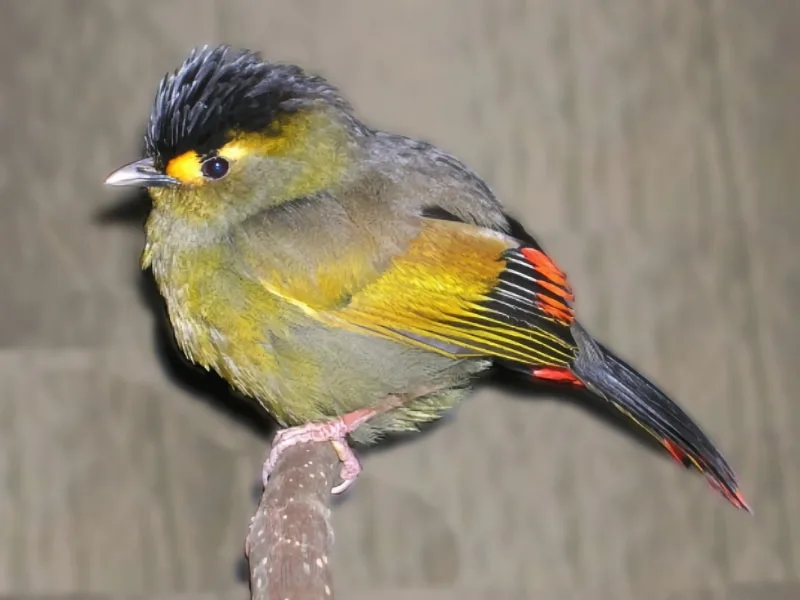
The Bugun liocichla was first observed in 1995 by astrophysicist and birdwatcher Ramana Athreya in the Eaglenest Wildlife Sanctuary, Arunachal Pradesh, India. Due to its rarity, it wasn’t until May 2006 that Athreya was able to capture and examine two individuals using mist nets, leading to its formal description as a new species. Remarkably, no type specimen was collected to avoid harming the limited population; instead, feathers, photographs, and recordings were used for documentation. This small babbler, approximately 20 cm in length, features olive-grey plumage, a distinctive black cap, prominent orange-yellow lores, and wings adorned with yellow, red, and white patches. It inhabits disturbed hillsides with shrubs and small trees at elevations around 2,000 meters.
Classified as Critically Endangered by the IUCN, the Bugun liocichla is known from a single location with an estimated population of fewer than 50 individuals. Its restricted range and small population make it highly susceptible to habitat disturbances, including plans for infrastructure development within its habitat. Conservation efforts are imperative to protect this species, focusing on habitat preservation and mitigating potential threats from human activities.
Hocking’s parakeet (Aratinga hockingi)
- Discovered: 2006.
- Location: Peru.
- Discovered by: Thomas Arndt.
Hocking’s parakeet was described in 2006 by Thomas Arndt as a distinct species within the Aratinga mitrata complex. Based on morphological differences, A. hockingi was distinguished from A. mitrata by having reduced red coloration on the head and thighs. Arndt’s study, which examined 130 specimens, also elevated Aratinga mitrata alticola to species status and described two new subspecies: A. mitrata chlorogenys and A. mitrata tucumana.
Despite this proposed classification, the South American Classification Committee (SACC) reviewed the taxonomic revision and found insufficient evidence to support the separation of A. hockingi from A. mitrata. The proposal was rejected, and A. hockingi is not recognized as a full species by major ornithological authorities. Ongoing research may clarify its status, but for now, it remains a debated taxon rather than an officially accepted species.
Camiguin hanging parrot (Loriculus camiguinensis)
- Discovered: 2006.
- Location: Camiguin Island, Philippines.
- Discovered by: J. G. Tello, J. F. Degner, J. M. Bates, D. E. Willard.
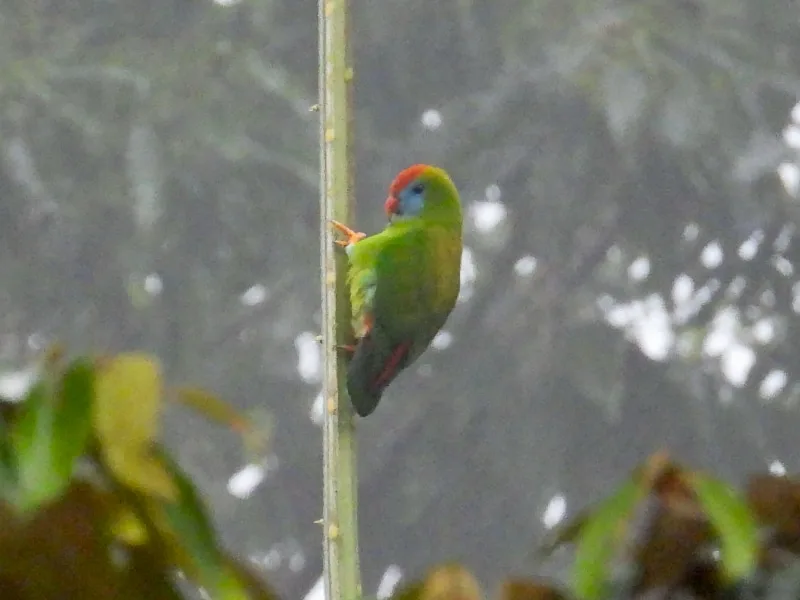
The Camiguin hanging-parrot was formally described in 2006 by Jose G. Tello and his colleagues based on 23 specimens collected in the 1960s on Camiguin Island. This species is predominantly green with a red crown and tail, and blue markings on the throat, face, and thighs. It is unique among Philippine Loriculus species in lacking sexual dimorphism, as both males and females share the same coloration. Morphologically, it most resembles Loriculus philippensis worcesteri and L. p. apicalis but differs in its crown patch size, intensity of blue in the face and thighs, and the amount of blue in the tail. Males are also larger, with significantly longer tails and wing chords than nearby populations.
While its population size remains unknown, the species is of conservation concern due to the small size of Camiguin Island and extensive deforestation. The remaining suitable habitat is fragmented, and the ongoing pet trade may further threaten the species. Protecting Camiguin’s forests is critical for its survival.
Bougainville bush warbler (Horornis haddeni)
- Discovered: 2006.
- Location: Crown Prince Range, Bougainville Island, Papua New Guinea.
- Discovered by: Mary LeCroy and F. Keith Barker.
- Current status: Near Threatened.
The Bougainville bush warbler, locally known as odedi, was first identified by Jared Diamond in 1972 during an expedition on Mount Balbi, where he recorded its distinctive song. Despite this initial observation, the species remained undescribed until 2006, when Mary LeCroy and F. Keith Barker conducted a formal description based on both morphological and genetic analyses. Initially classified under the genus Cettia, it was later reassigned to Horornis following phylogenetic studies. This elusive bird inhabits dense montane forests between 800 and 1,500 meters above sea level.
Currently assessed as Near Threatened by the IUCN, the Bougainville bush warbler faces potential threats from habitat loss due to deforestation and shifting agriculture. While its population is believed to be stable, the limited range and ongoing environmental pressures necessitate continued monitoring and conservation efforts.
Bird species discovered and recognized in 2005:
Stiles’s tapaculo (Scytalopus stilesi)
- Discovered: 2005.
- Location: Cordillera Central, Colombia.
- Discovered by: A. M. Cuervo, C. D. Cadena, N. Krabbe, and L. M. Renjifo.
- Current status: Least Concern.
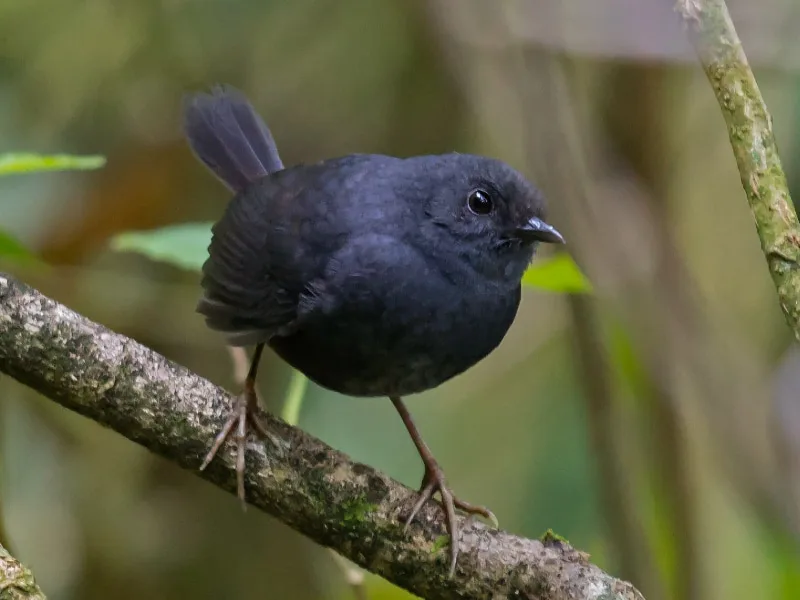
Stiles’s tapaculo was described in 2005 after researchers identified its distinct vocalizations and genetic differences from closely related species such as the Ecuadorian tapaculo (Scytalopus robbinsi). Found in the northern Cordillera Central of the Colombian Andes, it inhabits cloud forests between 1,420 and 2,130 meters in elevation. The species is locally common, but its range remains restricted, and ongoing deforestation poses a long-term threat.
The tapaculo is a small, secretive understorey bird, predominantly dark grey with buff barring on the lower flanks. Its song is faster and lower-pitched compared to its relatives, aiding identification. Although currently classified as Least Concern, habitat loss due to agricultural expansion, particularly for coffee plantations and livestock grazing, continues to impact its populations. Conservation efforts focused on protecting montane forests will be crucial for maintaining healthy populations in the future.
Naung Mung wren-babbler (Napothera naungmungensis)
- Discovered: 2005.
- Location: Northern Myanmar.
- Discovered by: John H. Rappole, Swen C. Renner, Nay Myo Shwe, and Paul R. Sweet.
- Current status: Near Threatened.
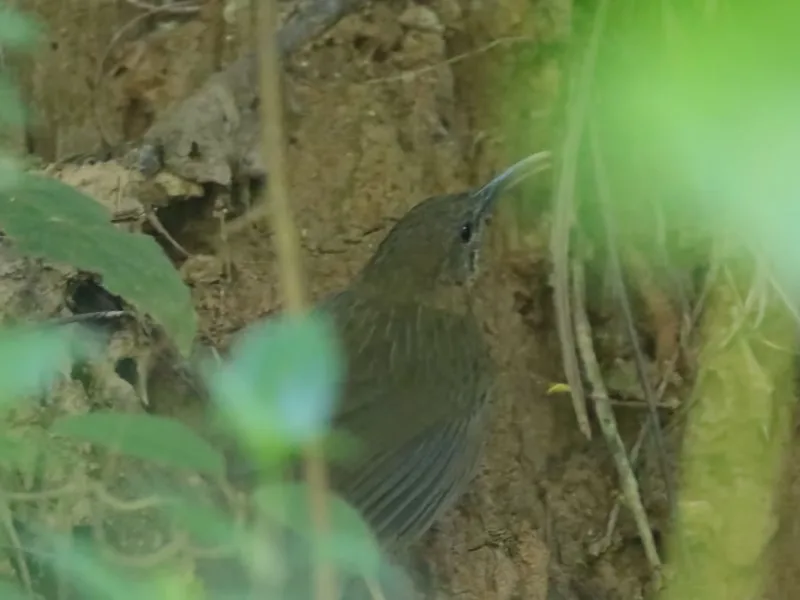
The Naung Mung wren-babbler was first documented in 2004 during avian surveys in the remote sub-Himalayan forests of northern Myanmar, near the village of Naung Mung. Initially classified as a scimitar-babbler (Jabouilleia naungmungensis), taxonomic revisions later reassigned it to Napothera, aligning it more closely with wren-babblers. The species is distinguished by its long, decurved bill, dark brown plumage, a single bold black malar stripe, and relatively short wings and tail.
The species is known only from its type locality in northern Myanmar, with no confirmed records outside this area. It inhabits dense undergrowth in humid premontane rainforests at moderate elevations, but its total range remains poorly understood. While it appears to be locally common, its restricted distribution and ongoing habitat degradation contribute to conservation concerns. More field research is needed to assess its population size and range accurately.
Iquitos gnatcatcher (Polioptila clementsi)
- Discovered: 2005.
- Location: Loreto, Peru.
- Discovered by: Bret M. Whitney and José Alvarez Alonso.
- Current status: Critically Endangered.
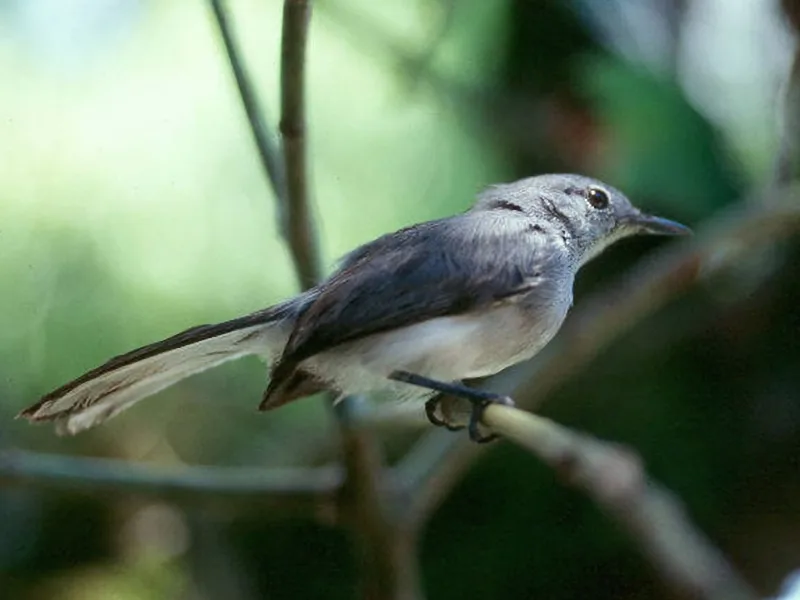
The Iquitos gnatcatcher was formally described in 2005 after researchers identified its distinct vocalizations and morphology within the Polioptila guianensis complex. It is endemic to the Allpahuayo-Mishana National Reserve, near Iquitos in northern Peru, where it inhabits tall, humid white-sand forest (varillal) with a variable canopy height between 15 and 30 meters. Despite extensive surveys, only 15 territorial pairs have been documented, and the species appears to be declining rapidly due to habitat loss.
The bird is small and pale grey, with a broken white eyering, black legs, and distinctive white corners on the tail. Unlike most gnatcatchers, males lack any black on the head. The song features unique inverted chevron-shaped introductory notes, setting it apart from other species in the genus. Deforestation, illegal logging, and agricultural expansion continue to threaten the species’ already restricted range, placing it among the most critically endangered birds in the Amazon.
Magdalena tapaculo (Scytalopus rodriguezi)
- Discovered: 2005.
- Location: Cordillera Central, Colombia.
- Discovered by: N. Krabbe, P. Salaman, A. Cortés, A. Quevedo, L. A. Ortega, and C. D. Cadena.
- Current status: Endangered.

The Magdalena tapaculo was identified as a distinct species in 2005 after studies on specimens from the head of the Magdalena Valley on the eastern slope of Colombia’s Cordillera Central. It was first suspected in 1986 when recordings of its vocalizations revealed differences from known tapaculo species. Further surveys in 2002-2003 confirmed its unique status.
A small, secretive bird, it has slate-grey plumage with buff-brown barring on the belly. It inhabits dense undergrowth in humid montane forests at 2,000-2,300 meters. Its known range is highly restricted, and habitat destruction through deforestation and livestock grazing threatens its survival. With an estimated range of just 169 sq km and continued habitat loss, the species is classified as Endangered by the IUCN.
Sulphur-breasted parakeet (Aratinga maculata)
- Discovered: 2005.
- Location: Pará, Brazil.
- Discovered by: L. F. Silveira, F. C. T. de Lima, and E. Höfling.
- Current status: Least Concern
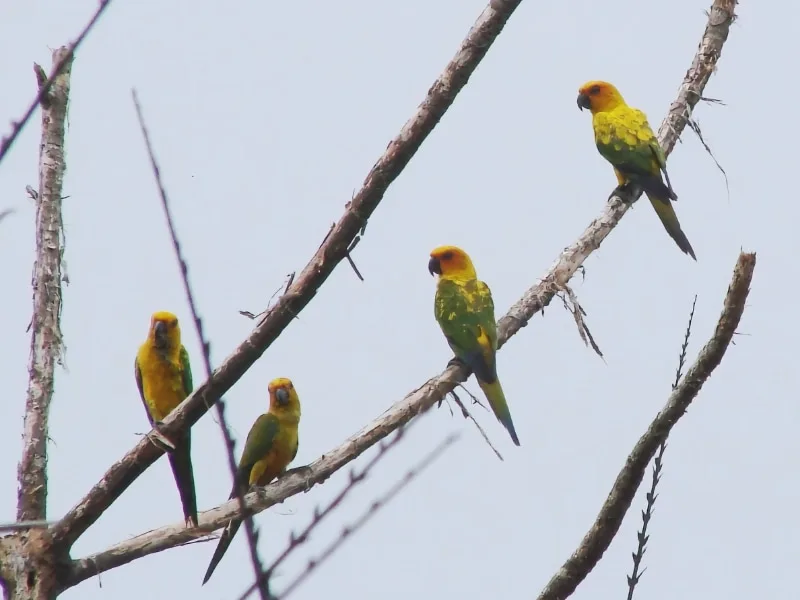
The sulphur-breasted parakeet was described as a distinct species in 2005 after museum specimens, previously mistaken for juvenile sun parakeets (Aratinga solstitialis) or hybrids, were reevaluated. This species is found on the northern bank of the lower Amazon River in the state of Pará, Brazil, where it inhabits open areas and forest edges. It was named in honor of Brazilian ornithologist Olivério Pinto, who was the first to note differences between A. pintoi and A. solstitialis.
The sulphur-breasted parakeet closely resembles the sun parakeet but has notable differences in plumage. It has green mottling on the yellow crown and nape (which are pure golden-yellow in A. solstitialis), a green mantle and upperwing-coverts with yellow suffusion (pure yellow in A. solstitialis), and predominantly yellow underparts with pale orange restricted to the flanks and belly (deep orange from throat to belly in A. solstitialis). Though the species has a small range, it remains fairly common, and its conservation status is currently classified as Least Concern by the IUCN.
Planalto tapaculo (Scytalopus pachecoi)
- Discovered: 2005.
- Location: Southern Brazil (Rio Grande do Sul, Santa Catarina) and northeastern Argentina (Misiones Province).
- Discovered by: M. R. Bornschein, J. F. Pacheco, G. A. Maurício.
- Current status: Least Concern.
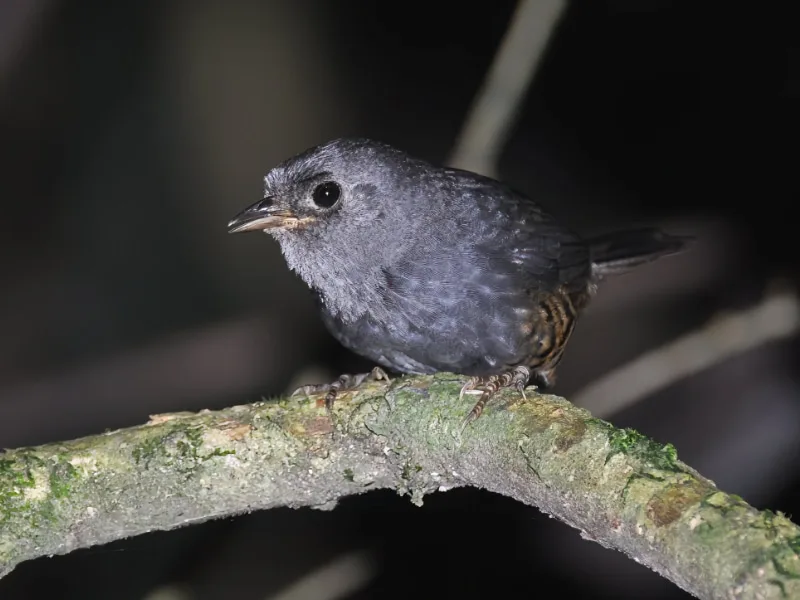
The Planalto tapaculo was described as a distinct species in 2005 after being separated from the Scytalopus speluncae complex. This small passerine is dark grey with paler underparts, while its flanks have buff-colored barring – an important feature distinguishing it from the similar mouse-colored tapaculo (Scytalopus speluncae). It is primarily found in dense undergrowth, bamboo thickets, and along streams in forested areas of southern Brazil and northeastern Argentina, where it is often more abundant in secondary forest than in undisturbed habitats.
The species is best identified by its unique vocalizations, including a slow series of notes that accelerates into a trill, differentiating it from related tapaculos. Despite its limited and fragmented range, the Planalto tapaculo is classified as Least Concern due to its ability to thrive in degraded and second-growth forests. It benefits from occurring in several protected areas, ensuring some level of habitat stability, though continued deforestation remains a concern.
Rubeho forest partridge (Xenoperdix obscuratus)
- Discovered: 2005.
- Location: Rubeho Highlands, Tanzania.
- Discovered by: Rauri C.K. Bowie and Jon Fjeldså.
- Current status: Endangered.
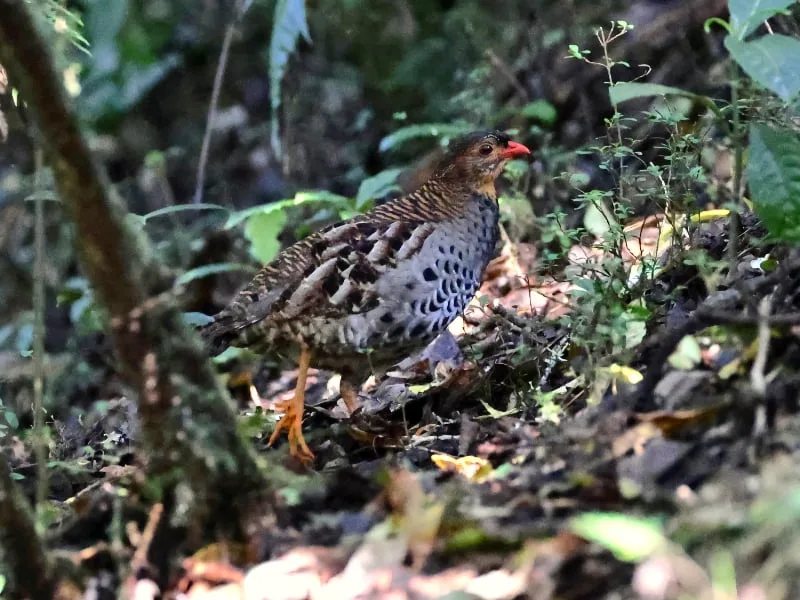
The Rubeho forest partridge was initially classified as a subspecies of the Udzungwa forest partridge (Xenoperdix udzungwensis) when first described in 2003. However, a detailed genetic and morphological study in 2005 confirmed it as a distinct species. It is endemic to the Rubeho Highlands of Tanzania, where it inhabits montane forests at elevations between 1,350 and 1,900 meters.
This species is characterized by its boldly barred brownish plumage, rufous face, grey underparts, and a red bill. It primarily feeds on beetles, ants, and seeds while foraging on the forest floor. Like its closest relative, the Udzungwa forest partridge, it is highly threatened by habitat loss, small population size, and overhunting. The clearing of forests for agriculture and logging, combined with unsustainable hunting practices, has led to its classification as Endangered, highlighting the urgent need for conservation efforts to protect its limited range.
Bird species discovered and recognized in 2004:
Mees’s nightjar (Caprimulgus meesi)
- Discovered: 2004.
- Location: Flores and Sumba, Indonesia
- Discovered by: George Sangster and Frans G. Rozendaal.
- Current status: Least Concern.
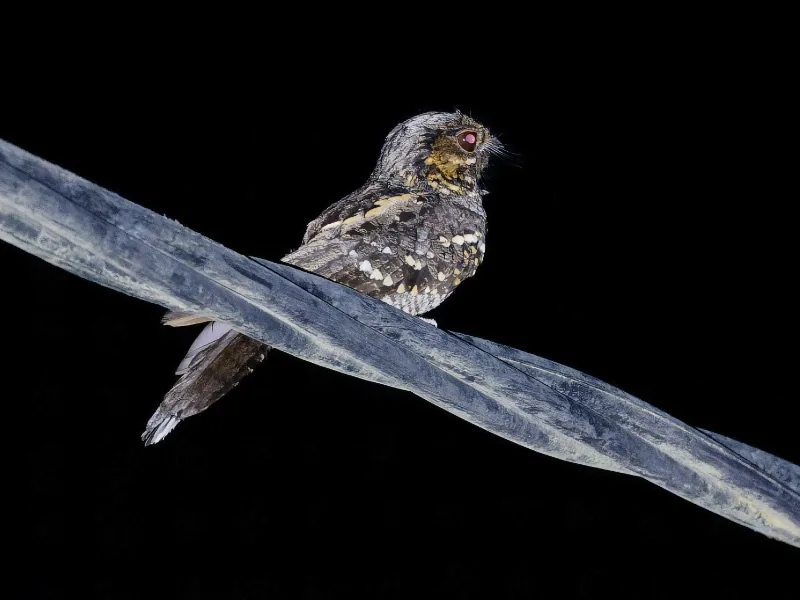
The Mees’s nightjar was recognized as a separate species in 2004 after researchers analyzed its unique vocalizations, distinguishing it from other members of the Caprimulgus macrurus complex. It was named in honor of Dutch ornithologist Gerlof Mees. The species is found on Flores and Sumba, Indonesia, where it prefers scrublands, forest edges, and open woodlands.
Unlike some related nightjars, Caprimulgus meesi sings only from perches rather than in flight. Its territorial songs are most commonly heard from June to November, but little is known about its breeding behavior. Observations suggest that feeding occurs both on the wing and by sallying from perches. Despite its limited known range, Mees’s nightjar is considered common within suitable habitats, and the IUCN currently classifies it as Least Concern, indicating a stable population with no immediate threats.
Calayan rail (Aptenorallus calayanensis)
- Discovered: 2004.
- Location: Calayan Island, Babuyan Islands, Philippines.
- Discovered by: D. Allen, C. Oliveros, C. Española, G. Broad, J. C. T. Gonzalez.
- Current status: Vulnerable.
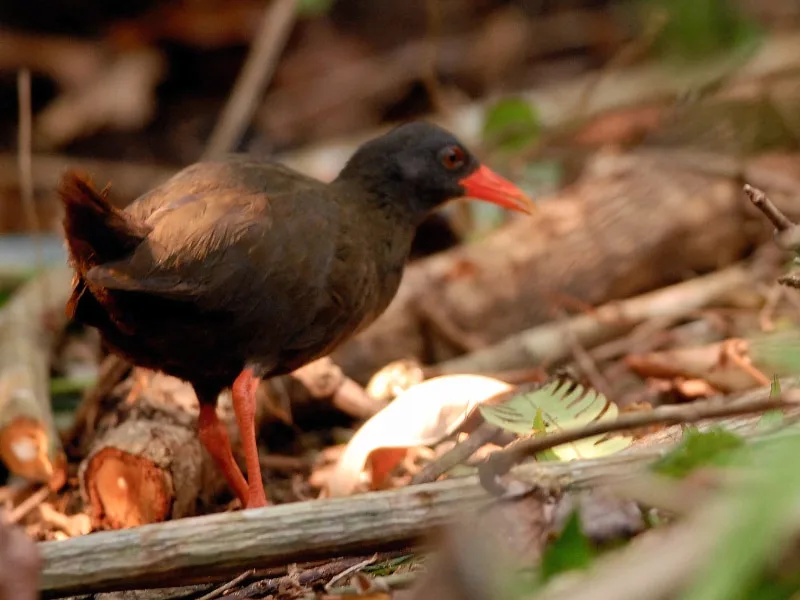
The Calayan rail was discovered in May 2004 by a team of Filipino and British researchers on Calayan Island in the Babuyan Islands, northern Philippines. Previously classified under the genus Gallirallus, recent phylogenetic studies have reclassified it as Aptenorallus calayanensis. Unlike its close relatives, this species is flightless and restricted to primary and secondary forests on coralline limestone with numerous sinkholes and caves.
This medium-sized rail has dark plumage with bright red legs and a red beak. It appears to be common within its preferred habitat, with an estimated density of one pair per 1-2 hectares, and an estimated 100-200 pairs in surveyed areas. While habitat degradation and infrastructure development could pose future threats, its current range is largely free of introduced predators. The species is occasionally caught in traps meant for red junglefowl (Gallus gallus), but is not directly targeted. Due to its small range and potential habitat disturbance, it is classified as Vulnerable.
Acre antshrike (Thamnophilus divisorius)
- Discovered: 2004.
- Location: Serra do Divisor, Acre, Brazil.
- Discovered by: Bret M. Whitney, David C. Oren, Robb T. Brumfield.
- Current status: Least Concern.
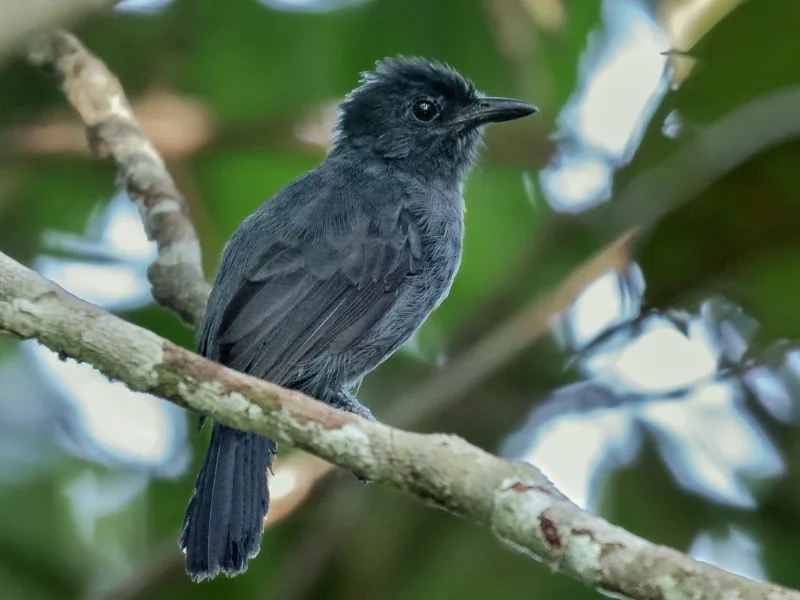
The Acre antshrike was first observed in 1996 in the Acre Arch uplands of western Brazil, within what is now Parque Nacional da Serra do Divisor. It was later described as a new species in 2004 by Bret M. Whitney, David C. Oren, and Robb T. Brumfield. Its closest relatives are the streak-backed antshrike (Thamnophilus insignis) and the Amazonian antshrike (Thamnophilus amazonicus).
This species inhabits stunted ridge woodlands with a broken canopy and dense undergrowth, growing on thin soils at higher elevations. Despite its small known range, it appears to be common within its habitat, and there are no immediate threats to its survival. It is currently classified as Least Concern by the IUCN, but future deforestation or environmental changes could impact its status.
Serendib scops-owl (Otus thilohoffmanni)
- Discovered: 2004.
- Location: Lowland rainforests, Sri Lanka.
- Discovered by: Deepal Warakagoda and Pamela C. Rasmussen.
- Current status: Endangered.
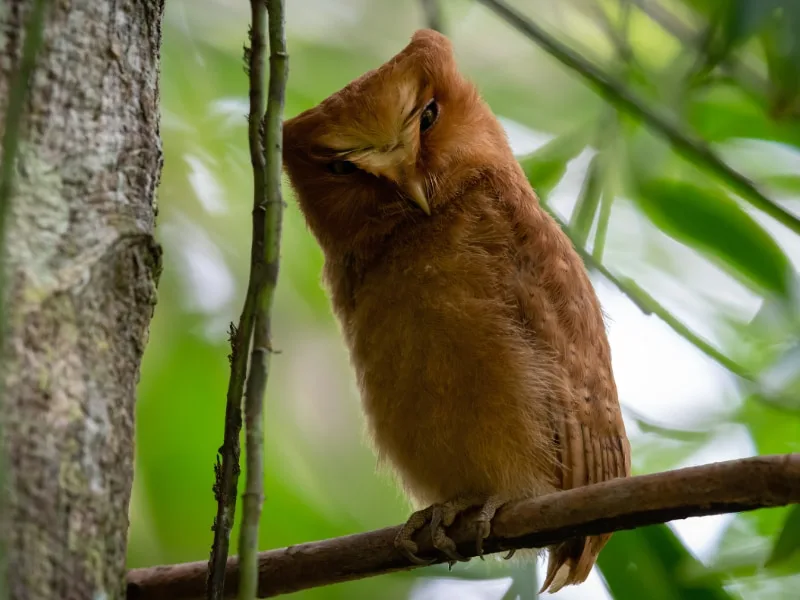
The Serendib scops-owl was first detected in 1995 when Deepal Warakagoda heard an unfamiliar owl-like call in the rainforests of Sri Lanka. Initially, some ornithologists speculated that the sound came from an arboreal amphibian, but Warakagoda confirmed the bird’s identity when he saw it in 2001. It was formally described in 2004, making it the first new species of bird discovered in Sri Lanka in over 130 years. The name Serendib refers to an old name for Sri Lanka, while thilohoffmanni honors conservationist Thilo W. Hoffmann.
This small, rufous-colored owl is unique among scops-owls for lacking ear tufts and having a distinctive slow, whistle-like call. It inhabits lowland rainforests below 200 meters and is nocturnal, roosting in dense foliage during the day. Due to extensive deforestation and habitat loss, its tiny range and small population make it one of the most endangered owls in the world, with fewer than 500 mature individuals estimated to survive. Conservation efforts are ongoing, but continued forest protection is essential for its survival.
Rubeho akalat (Sheppardia aurantiithorax)
- Discovered: 2004.
- Location: Rubeho Highlands, Eastern Arc Mountains, Tanzania.
- Discovered by: Per Beresford, Jon Fjeldså and Jacob. Kiure.
- Current status: Endangered.
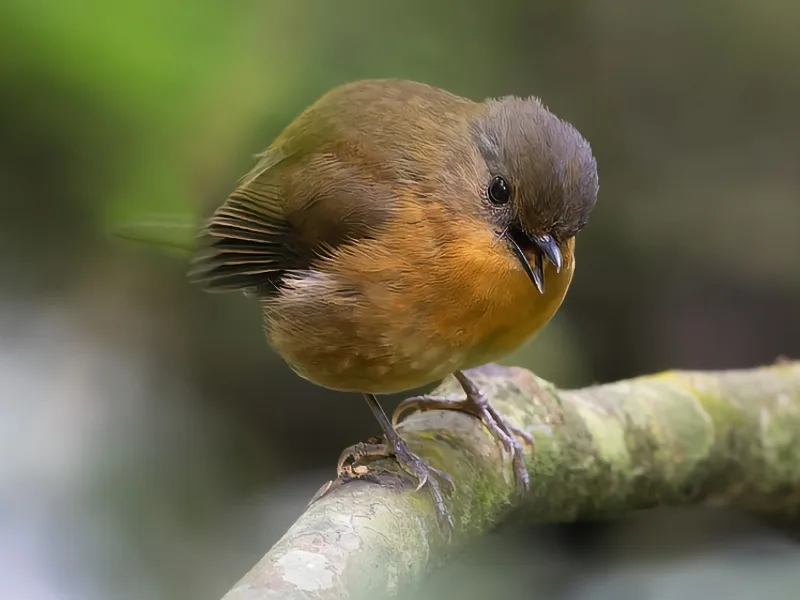
The Rubeho akalat was initially thought to be an isolated population of the Iringa akalat (Sheppardia lowei), but further specimens collected in 2000 led to its formal description as a distinct species in 2004 by Per Beresford, Jon Fjeldså, and Jacob Kiure. Its English name refers to the Rubeho Highlands, its only known habitat, while its scientific name (aurantiithorax) refers to the ochraceous-orange coloration on its throat and upper breast.
The Rubeho akalat inhabits montane forests between 1,400 and 2,250 meters in elevation, where it is thought to be fairly common but highly localized. It prefers dense undergrowth, particularly in forested ravines and along streams. While habitat within its range remains largely intact, deforestation and forest fragmentation pose increasing threats. Due to its small range and potential habitat loss, the species is currently classified as Endangered.
Togian boobook (Ninox burhani)
- Discovered: 2004
- Location: Togian Archipelago, Indonesia
- Discovered by: Mochamad Indrawan and Sunarto Somadikarta.
- Current status: Near Threatened.

The Togian boobook, also known as Togian hawk-owl, was first observed on Christmas night in 1999 in Benteng village, Togian Island, when three unidentified owls were spotted hunting by torchlight. It was later confirmed as a new species and formally described in 2004 by Mochamad Indrawan and Sunarto Somadikarta. The species is named after Burhan, a local conservationist who assisted in its discovery.
This medium-sized hawk-owl has a dark facial disc, pale-scalloped mantle, grey bill, white underwings, and finely spotted undertail feathers. It is found in lowland and hill forests across the Togian, Malenge, and Batudaka islands and possibly Waleabahi Island. Though it appears moderately common, habitat loss due to deforestation remains a significant threat. The IUCN currently classifies it as Near Threatened, meaning it is at risk of becoming threatened if habitat destruction continues. Conservation efforts are essential to monitor population trends and protect its remaining forest habitat.
Bird species discovered and recognized in 2003:
Carrizal seedeater (Amaurospiza carrizalensis)
- Discovered: 2003.
- Location: Caroní River, Venezuela.
- Discovered by: Miguel Lentino and Robin Restall.
- Current status: Endangered.
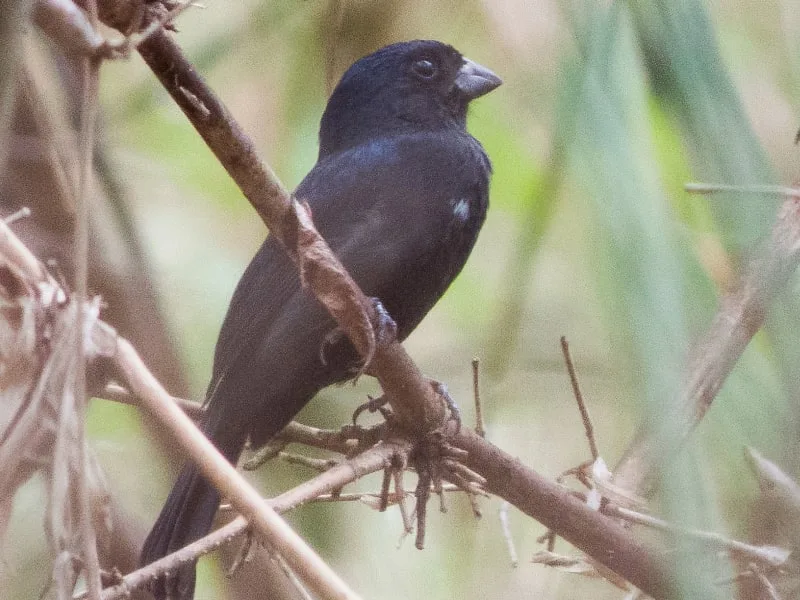
The carrizal seedeater was first discovered in 2001 on Isla Carrizal in the Caroní River, Venezuela, and formally described in 2003. This striking bird was completely unknown to science before its discovery. Unfortunately, its type locality was destroyed shortly afterward when the Guri Dam flooded the area, wiping out its original habitat. Fortunately, later surveys found the species in several nearby locations, suggesting it has a slightly larger range than initially feared.
This small stocky seedeater is sexually dimorphic. The male has glossy dark slaty-blue plumage, blackish wings, and white underwing coverts, while the female is warm brown with yellow-buff underparts. It inhabits dense spiny bamboo forests and has a specialized diet of seeds and beetles. Due to its tiny estimated population, possibly fewer than 50 mature individuals, and the continued destruction of its habitat, conservation efforts are crucial to ensure the survival of this extremely rare species.
Munchique wood wren (Henicorhina negreti)
- Discovered: 2003.
- Location: Western Andes, Colombia.
- Discovered by: Paul Salaman, Paul Coopmans, Thomas Donegan, and colleagues.
- Current status: Vulnerable.
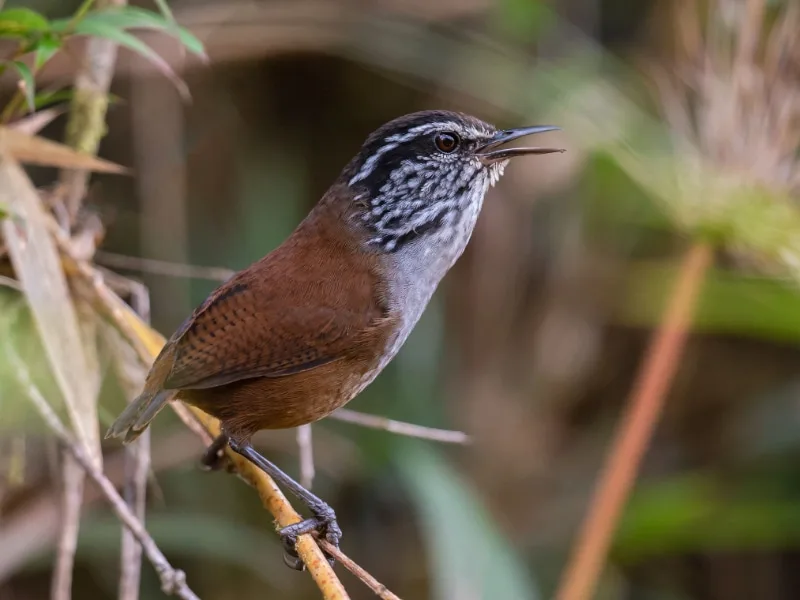
The Munchique wood wren was first observed in the 1980s by ornithologist Steven Hilty but remained undescribed until 2003, when Paul Salaman and colleagues formally recognized it as a distinct species. Found in Colombia’s Western Andes, particularly in the Munchique Massif and surrounding high-altitude cloud forests, this species is distinguished from the grey-breasted wood wren (Henicorhina leucophrys) by its vocalizations and habitat preference.
Restricted to dense, wet cloud forests at elevations between 2,250 and 2,640 meters, the Munchique wood-wren is highly vulnerable to deforestation and climate change. Forest clearance not only reduces habitat but also leads to drying conditions, allowing competing species to expand into its range. Although initially classified as Critically Endangered, further surveys revealed a larger population than expected, leading to its downlisting to Vulnerable in 2018. However, its tiny area of suitable habitat means that ongoing conservation efforts remain critical to its survival.
Okarito kiwi (Apteryx rowi)
- Discovered: 2003.
- Location: Okarito Forest, West Coast, South Island, New Zealand.
- Discovered by: A. J. D. Tennyson, R. L. Palma, H. A. Robertson, T. H. Worthy, B. J. Gill.
- Status: Vulnerable.
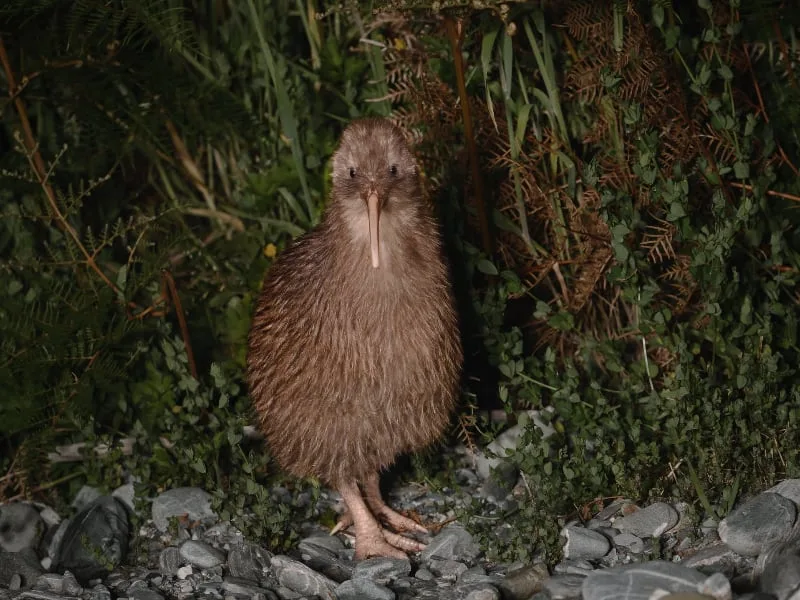
The Okarito kiwi, also known as the rowi or Okarito brown kiwi, was formally described as a distinct species in 2003 by Alan J. D. Tennyson and colleagues. Prior to this, it was considered a population of the South Island brown kiwi (Apteryx australis). Genetic analyses revealed that the Okarito kiwi is more closely related to the North Island brown kiwi (Apteryx mantelli), leading to its recognition as a separate species. This species is endemic to a restricted area of the Okarito Forest on the West Coast of New Zealand’s South Island.
The Okarito kiwi is a medium-sized, flightless bird with soft, pale brown feathers streaked with brown and black. It possesses a long, pale bill and short, pale legs, toes, and claws. Males emit a high-pitched ascending whistle repeated 15-25 times, while females produce a slower, lower-pitched hoarse guttural call repeated 10-20 times. Due to habitat loss and predation by introduced species, the Okarito kiwi is classified as Vulnerable. Conservation efforts, including habitat protection and predator control, are ongoing to support the recovery of this rare and unique species.
Bird species discovered and recognized in 2002:
Bald parrot (Pyrilia aurantiocephala)
- Discovered: 2002.
- Location: Lower Madeira and Upper Tapajós Rivers, Amazonian Brazil.
- Discovered by: R. Gaban-Lima, M. A. Raposo, and E. Höfling
- Current status: Near Threatened.
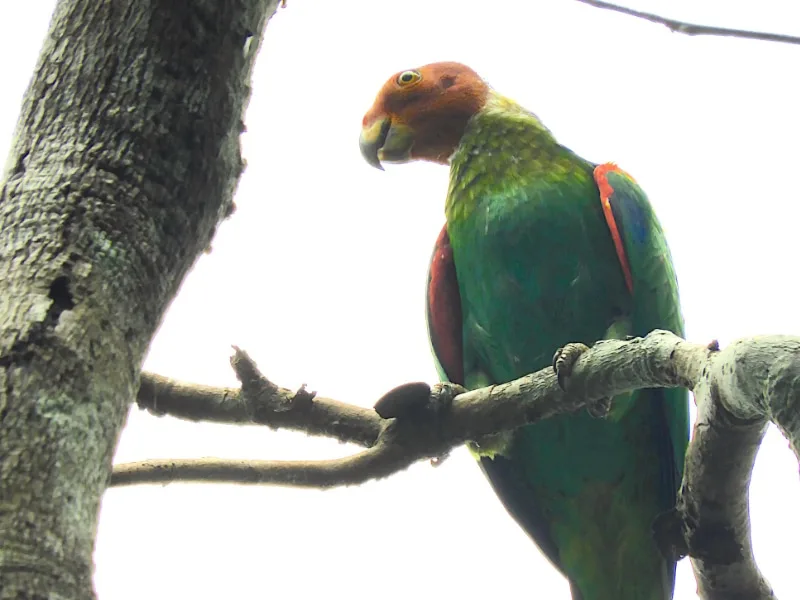
The bald parrot was formally described in 2002 by Renato Gaban-Lima and colleagues after being previously mistaken for the juvenile form of the vulturine parrot (Pyrilia vulturina). This medium-sized parrot is distinguished by its striking orange, featherless head and predominantly green plumage. Researchers identified it as a distinct species when they discovered that the bald, orange-headed individuals were sexually mature adults with fully ossified skulls – traits inconsistent with juveniles of P. vulturina. Further examination of museum specimens revealed no intermediate forms linking the two species, confirming the bald parrot’s uniqueness.
Endemic to Amazonian Brazil, the Bald Parrot is known from a few localities along the Lower Madeira and Upper Tapajós rivers. It inhabits gallery forests and “campinarana” white-sand forests, both of which are increasingly threatened by logging and deforestation. Due to its limited range and habitat pressures, the population is estimated to be fewer than 10,000 individuals, leading to its classification as Near Threatened by the IUCN. As more areas are surveyed, additional populations may be identified, but ongoing habitat degradation poses a significant risk to its long-term survival.
Cryptic forest falcon (Micrastur mintoni)
- Discovered: 2002.
- Location: Amazonian Brazil and northeastern Bolivia.
- Discovered by: Andrew Whittaker.
- Current status: Least Concern.
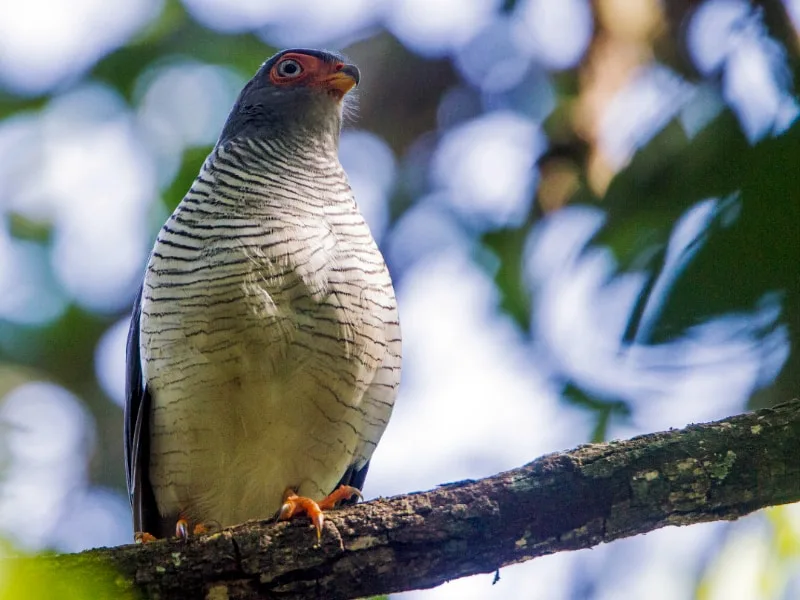
The cryptic forest falcon was long misidentified as either the lined forest falcon (Micrastur gilvicollis) or the plumbeous forest-falcon (Micrastur plumbeus) until Andrew Whittaker formally described it as a new species in 2002. Despite being present in museum collections for over a century, its distinct vocalizations and shorter tail set it apart from its closest relatives. Genetic and morphological analyses confirmed its status as a separate species.
This elusive raptor inhabits humid terra firme forests in central and eastern Amazonian Brazil, as well as northeastern Bolivia. A disjunct population formerly occurred in the Atlantic Rainforest of Brazil, but it may now be extinct due to deforestation. Like other forest-falcons, it is secretive and difficult to observe, relying on its call to communicate in the dense understory. Conservation concerns remain due to habitat destruction across its range, though it is currently assessed as Least Concern.
Kimberley pipit (Anthus pseudosimilis)
- Discovered: 2002.
- Location: South Africa and Namibia.
- Discovered by: Richard Liversidge and Gary Voelker.
- Current status: Taxonomic status debated.
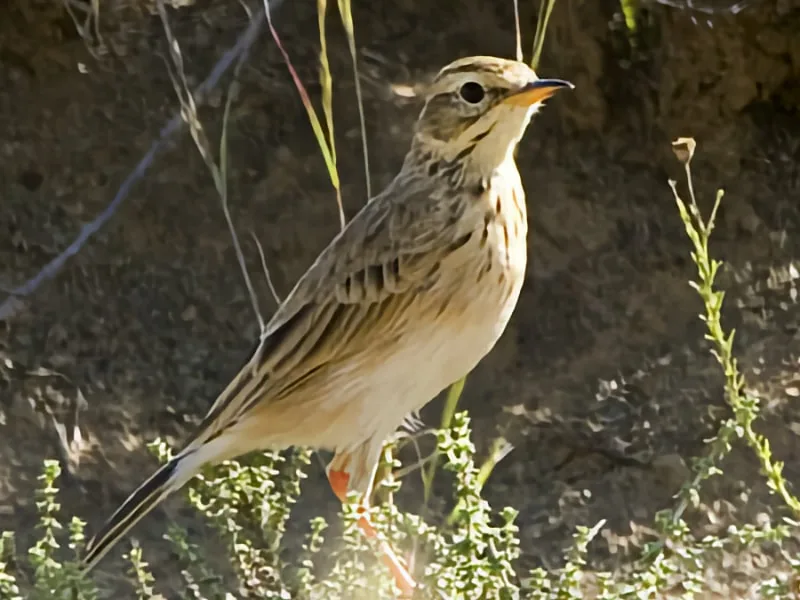
The Kimberley pipit was initially misidentified as the long-billed pipit (Anthus similis) until DNA analysis by Richard Liversidge and Gary Voelker in 2002 revealed its closer genetic relationship to the Malindi pipit (Anthus melindae). Morphological comparisons further confirmed distinct differences in wing structure, bill shape, and vocalizations, supporting its classification as a separate species.
Endemic to the grassy plains of South Africa and southwestern Namibia, the species exhibits behaviors and habitat preferences that overlap with several other pipit species, leading to ongoing debate over its taxonomic status. While it appears to be locally common in suitable habitat, further studies are needed to clarify its classification and distribution.
Least boobook (Ninox sumbaensis)
- Discovered: 2002.
- Location: Sumba Island, Indonesia.
- Discovered by: J. Olsen, M. Wink, H. Sauer-Gürth, S. Trost.
- Status: Endangered.
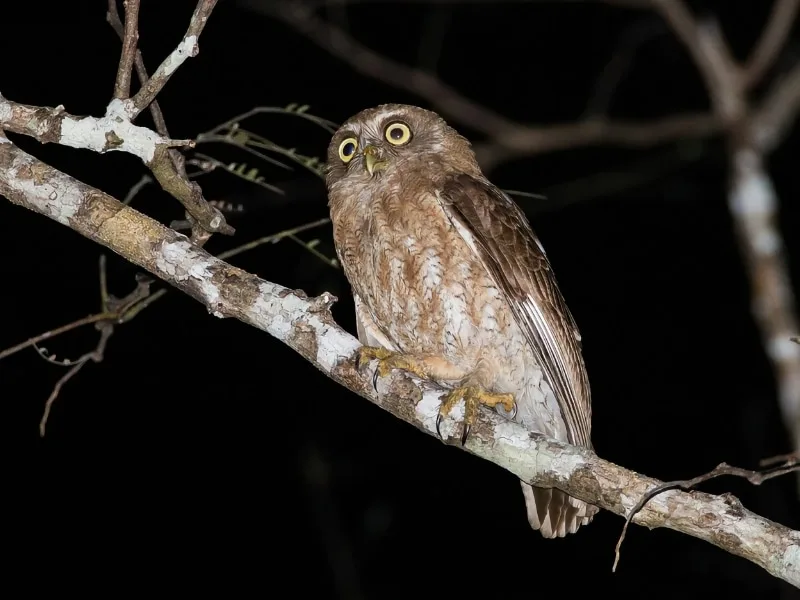
Since the late 1980s, reports of an unidentified owl from Sumba Island, Indonesia, suggested the presence of a distinct species within the genus Otus. However, DNA analysis later confirmed that this bird belonged to the Ninox genus, yet it differed significantly from other Ninox species found in Indonesia. Formally described in 2002 by Jerry Olsen and his colleagues, the least boobook, also known as the little Sumba hawk-owl, is a small owl measuring about 23 cm in length and weighing around 90 grams. It has a grey head with fine dark barring, white eyebrows, and a large yellow beak, with light brown upperparts and whitish underparts marked with fine dark chevrons. Endemic to Sumba Island, it inhabits subtropical and tropical moist lowland forests, primarily at elevations around 600 meters.
The least boobook is distinguished by its low whistling call, a single “who” repeated every few seconds. Despite its elusive nature, it has been recorded in both primary and secondary forests but not in surrounding open areas. Habitat destruction due to deforestation poses an increasing threat to the species, making conservation efforts essential for its survival. Protecting the remaining forest on Sumba Island is critical to ensuring the future of this rare owl.
Madeira parakeet (Pyrrhura snethlageae)
- Discovered: 2002.
- Location: South-central Amazonian Brazil and northern Bolivia.
- Discovered by: Leo Joseph and John M. Bates.
- Status: Least Concern.
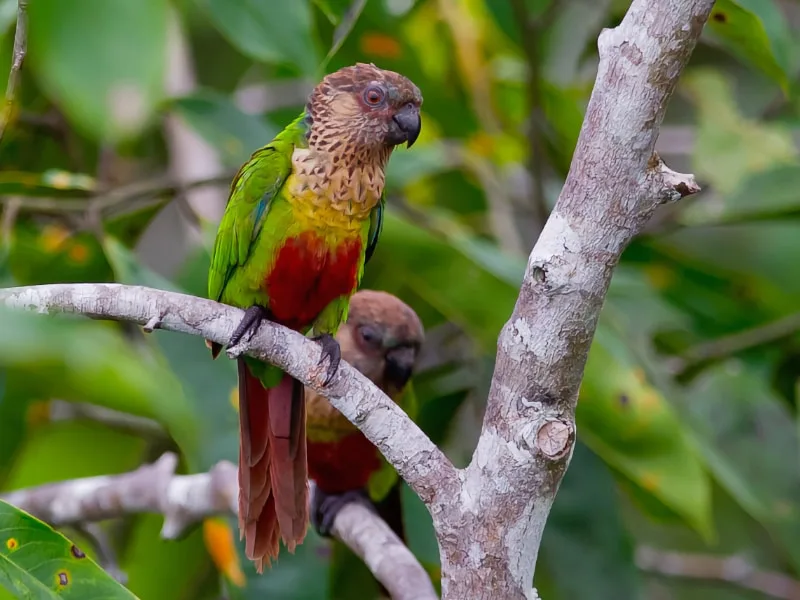
The Madeira parakeet, formally described in 2002 by ornithologists Leo Joseph and John M. Bates, was named in honor of German-born Brazilian naturalist and ornithologist Emilie Snethlage, who made significant contributions to the study of Amazonian birdlife in the early 20th century. This small parrot, approximately 22 cm in length, exhibits predominantly green plumage with a dark red belly, rump, and tail-tip. Distinctive features include a whitish or dull buff patch on the auriculars, bluish remiges, dark maroon cheeks, and pale grey scaling on the chest. Endemic to the Madeira River basin in south-central Amazonian Brazil and extending into northern Bolivia, the Madeira parakeet inhabits tropical humid lowland forests and adjacent habitats.
Initially described as a distinct species, the Madeira parakeet has undergone taxonomic revisions and has been considered a subspecies of the Santarem parakeet (Pyrrhura amazonum). Recent studies, including molecular analyses, have supported its recognition as a separate species. Despite being fairly common in parts of its range, the Madeira parakeet faces threats from habitat loss due to deforestation and land-use changes. Conservation efforts are essential to protect its habitat and ensure the survival of this vibrant parakeet.
Carajas woodcreeper (Xiphocolaptes carajaensis)
- Discovered: 2002.
- Location: Pará, Brazil.
- Discovered by: J. M. C. da Silva, F. C. Novaes, D. C. Oren.
- Status: Vulnerable.
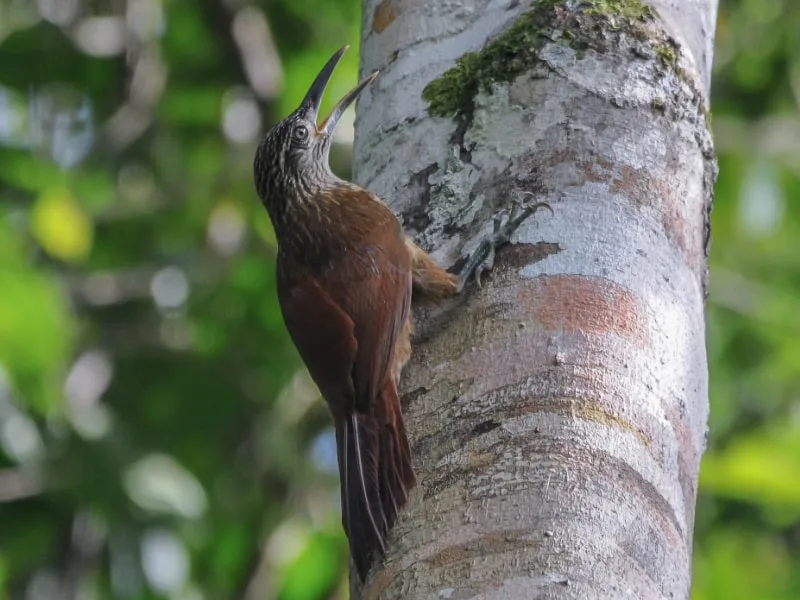
The Carajás woodcreeper was formally described in 2002 by José M. C. da Silva, Fernando C. Novaes, and David C. Oren. This species is endemic to the Carajás region in the state of Pará, Brazil, inhabiting tropical moist lowland forests. It is characterized by its robust size and strong bill, adapted for foraging on tree trunks and branches. The plumage is predominantly brown with subtle streaking, typical of woodcreepers.
Taxonomically, the Carajás woodcreeper has been a subject of debate. While some authorities recognize it as a distinct species, others consider it a subspecies of the strong-billed woodcreeper (Xiphocolaptes promeropirhynchus). Due to this uncertainty, the species has not been assessed separately by the IUCN. However, its restricted range in Pará, Brazil, combined with ongoing deforestation and mining activities in the region, suggests that its population could be at risk. Conservation efforts are crucial to protect its habitat and prevent further decline.
Pernambuco pygmy owl (Glaucidium mooreorum)
- Discovered: 2002.
- Location: Pernambuco, Brazil.
- Discovered by: J. M. C. da Silva, G. Coelho, L. P. Gonzaga.
- Status: Critically Endangered.
The Pernambuco pygmy-owl was formally described in 2002 by José M. C. da Silva, Galileu Coelho, and Luiz P. Gonzaga, based on two specimens collected in 1980 from the Reserva Biológica de Saltinho in Pernambuco, Brazil. This small owl, approximately 13 cm in length and weighing about 51 grams, features a light grey-chestnut crown and head speckled with conspicuous white spots extending to the lower nape. It has a white collar, chestnut back, and white underparts streaked with rufous. Endemic to the Atlantic coastal forests of northeastern Brazil, the species has been observed in the canopy of tall, humid, lowland forests at elevations up to 150 meters.
Despite targeted surveys since 2004 in Pernambuco and Alagoas states, the Pernambuco pygmy-owl has not been observed, leading to concerns that it may be extinct. The species occupies a tiny and severely fragmented range, and its habitat has been extensively degraded due to deforestation, logging, and land conversion for agriculture and urban development. The IUCN has assessed the species as Critically Endangered and Possibly Extinct. Conservation efforts are urgently needed to protect any remaining habitat and to conduct further surveys to determine if any individuals survive.
Lafresnaye’s woodcreeper (Xiphorhynchus guttatoides)
- Discovered: 2002.
- Location: Amazon Basin, South America.
- Discovered by: Alexandre Aleixo.
- Status: Least Concern.
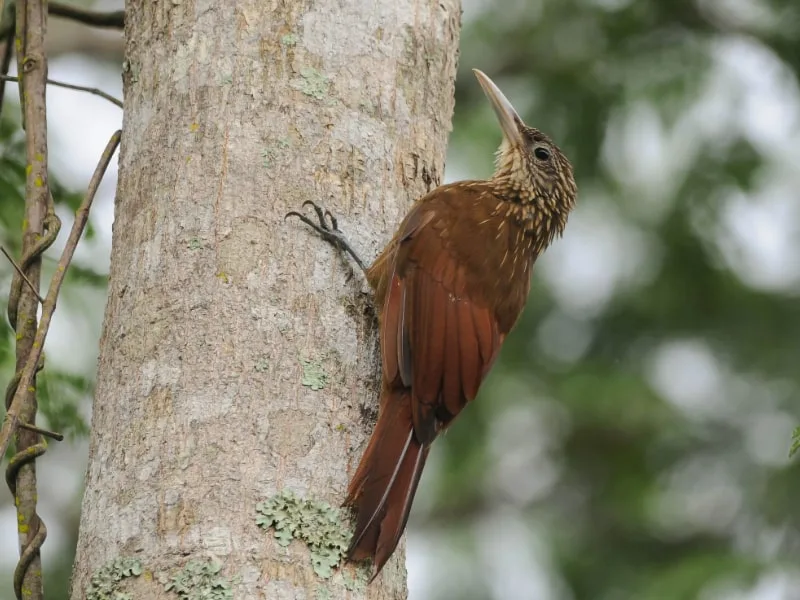
Previously considered a subspecies of the buff-throated woodcreeper (Xiphorhynchus guttatus), Lafresnaye’s woodcreeper was recognized as a distinct species in 2002 based on molecular evidence provided by Alexandre Aleixo. This genetic analysis demonstrated significant evolutionary divergence, supporting its classification as a separate species. It is distributed across the Amazon Basin, primarily in Peru, Bolivia, Ecuador, Colombia, and western Brazil, where it inhabits lowland and foothill rainforests.
Lafresnaye’s woodcreeper is a medium-sized bird with a distinctive buff-colored throat, brownish upperparts, and heavily streaked underparts. Like other woodcreepers, it forages along tree trunks and branches, using its strong bill to extract insects and other invertebrates from bark crevices. Its conservation status is currently assessed as Least Concern, as it remains widespread, although habitat loss from deforestation could impact populations in parts of its range.
Elegant woodcreeper (Xiphorhynchus elegans)
- Discovered: 2002 (elevated to species status).
- Location: Amazon Basin, South America.
- Discovered by: Alexandre Aleixo.
- Status: Least Concern.

The elegant woodcreeper was previously regarded as a subspecies of Spix’s woodcreeper (Xiphorhynchus spixii). In 2002, molecular studies conducted by Alexandre Aleixo provided evidence supporting its recognition as a separate species. This bird inhabits lowland and foothill rainforests across the Amazon Basin, including regions in Peru, Bolivia, Ecuador, Colombia, and western Brazil.
Medium-sized with a slender, slightly curved bill, the elegant woodcreeper exhibits a brownish body adorned with intricate streaking on its underparts and a distinctive buff-colored throat. Primarily arboreal, it forages along tree trunks and branches, feeding on insects and other invertebrates. Despite facing threats from deforestation and habitat fragmentation, the species is currently assessed as Least Concern due to its widespread distribution.
Tschudi’s woodcreeper (Xiphorhynchus chunchotambo)
- Discovered: 2002.
- Location: Eastern Andean slopes and adjacent Amazonian lowlands (Colombia, Ecuador, Peru, Bolivia, southwestern Brazil).
- Discovered by: Alexandre Aleixo.
- Status: Least Concern.
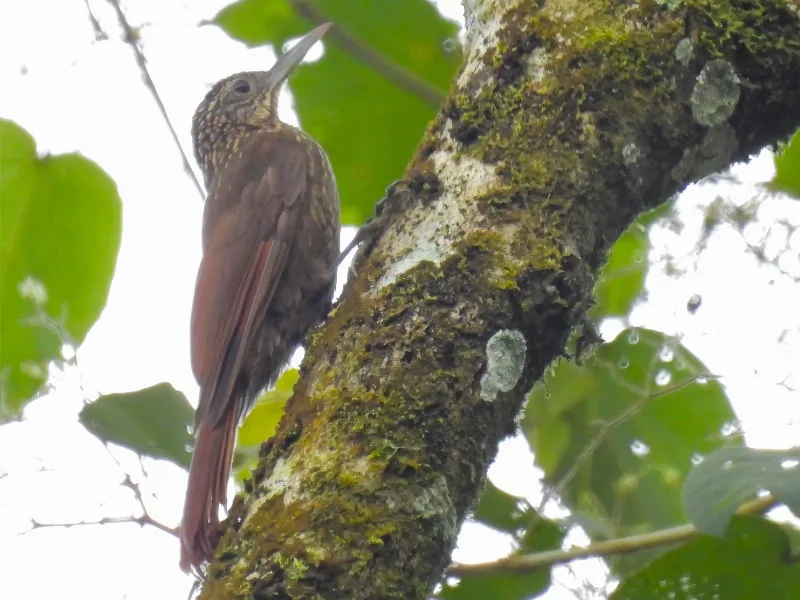
Originally described by Johann Jakob von Tschudi in 1844 as Dendrocolaptes chunchotambo, this species was long considered a subspecies of the ocellated woodcreeper (Xiphorhynchus ocellatus). However, in 2002, molecular studies by Alexandre Aleixo provided evidence for its recognition as a distinct species, highlighting genetic divergence between X. chunchotambo and its close relatives.
Tschudi’s woodcreeper inhabits humid forests along the eastern slopes of the Andes and adjacent Amazonian lowlands, ranging from Colombia through Ecuador, Peru, Bolivia, and into southwestern Brazil. It is a medium-sized woodcreeper, measuring about 20-21 cm in length, with brownish plumage, rufous wings and tail, a buff throat, and fine buff streaks on the back. The species is often observed in the lower and middle forest strata, frequently joining mixed-species foraging flocks.
Bird species discovered and recognized in 2001:
Mekong wagtail (Motacilla samveasnae)
- Discovered: 2001.
- Location: Lower Mekong Basin, Cambodia and Laos.
- Discovered by: J. W. Duckworth, P. Alström, P. Davidson, T. D. Evans, C. M. Poole, S. Tan, and R. J. Timmins.
- Current status: Near threatened.
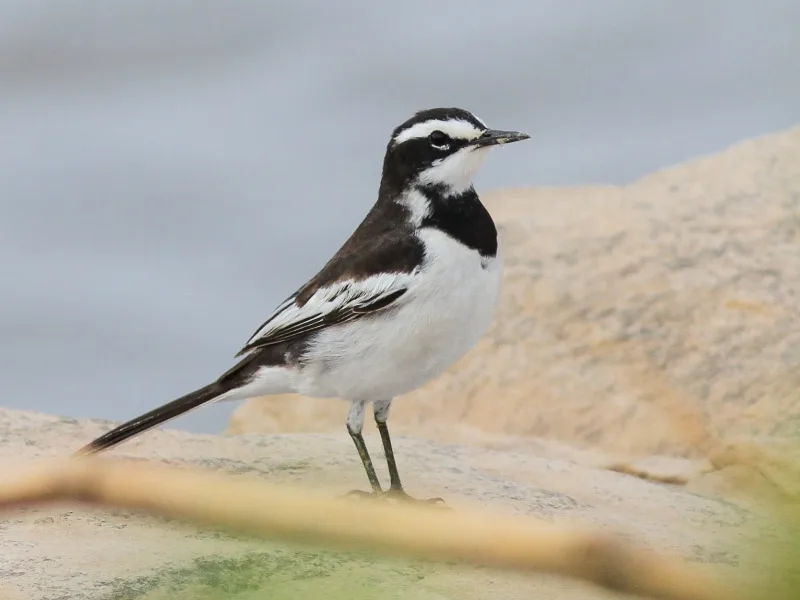
The Mekong wagtail was formally described in 2001 by J. W. Duckworth and colleagues and named in honor of Cambodian ornithologist Sam Veasna. Endemic to the lower Mekong basin, it breeds along the Mekong River and its tributaries in Cambodia and southern Laos, with a non-breeding record in Thailand. It thrives in riverine “channel mosaic” habitats – broad, lowland rivers with exposed rocky outcrops, gravel shoals, sandbars, and bushland. In optimal conditions, its densities can reach multiple pairs per kilometer, particularly in Cambodia where its numbers remain healthy.
This species closely resembles the African pied wagtail (Motacilla aguimp) but differs in wing patterns and vocalizations, with mitochondrial DNA indicating significant divergence. The Mekong wagtail is easily identifiable by its black forehead, lores, and ear coverts, contrasted with striking white supercilia, throat, and neck patch. Despite stable populations, it faces threats from potential dam construction along the Mekong River, leading to its near threatened classification by the IUCN.
Chestnut-eared laughingthrush (Ianthocincla konkakinhensis)
- Discovered: 2001.
- Location: Central Highlands, Vietnam.
- Discovered by: Jonathan C. Eames and Clotilde Eames.
- Current status: Vulnerable.
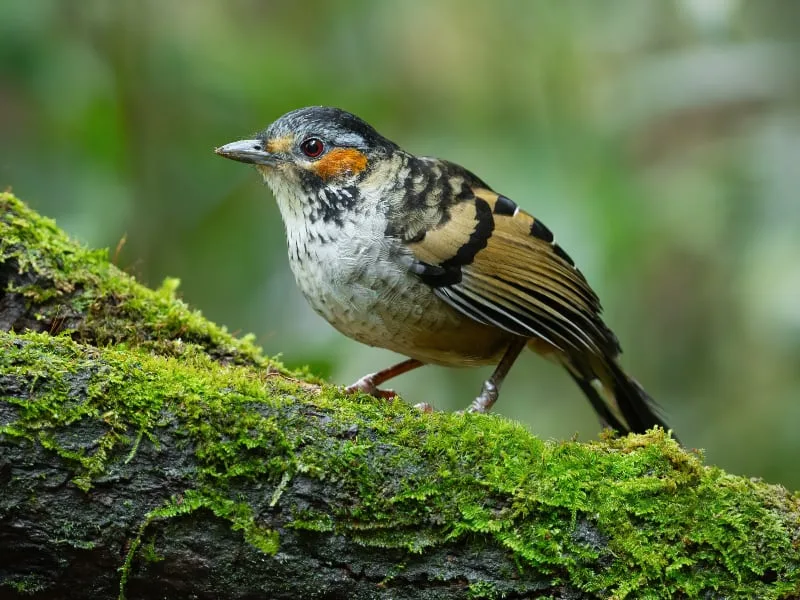
The chestnut-eared laughingthrush was described as a new species in 2001 by Jonathan C. Eames and Clotilde Eames following the collection of three specimens on Mount Kon Ka Kinh in Vietnam’s Central Highlands. This bird is characterized by boldly and irregularly barred black and white upperparts, a black-streaked grey forehead, chestnut ear-coverts, and a white-tipped tail with a broad black sub-terminal band. Initially placed in the genus Garrulax, it was reclassified to Ianthocincla after molecular phylogenetic studies in 2018.
Endemic to Vietnam, the species is currently known only from a small area in Kon Ka Kinh National Park, with potential but unconfirmed occurrences in adjacent regions and possibly Laos. It inhabits primary upper montane evergreen forests between 1,600 and 1,700 meters elevation, favoring dense undergrowth. The species demonstrates some tolerance for disturbed habitats, as evidenced by its presence in selectively logged forests. However, ongoing habitat degradation due to logging and shifting cultivation poses significant threats, leading to its classification as vulnerable.
Chapada flycatcher (Guyramemua affine)
- Discovered: 2001.
- Location: Cerrado region, central South America.
- Discovered by: Kevin J. Zimmer, Andrew Whittaker, and Dante C. Oren.
- Current status: Near threatened.
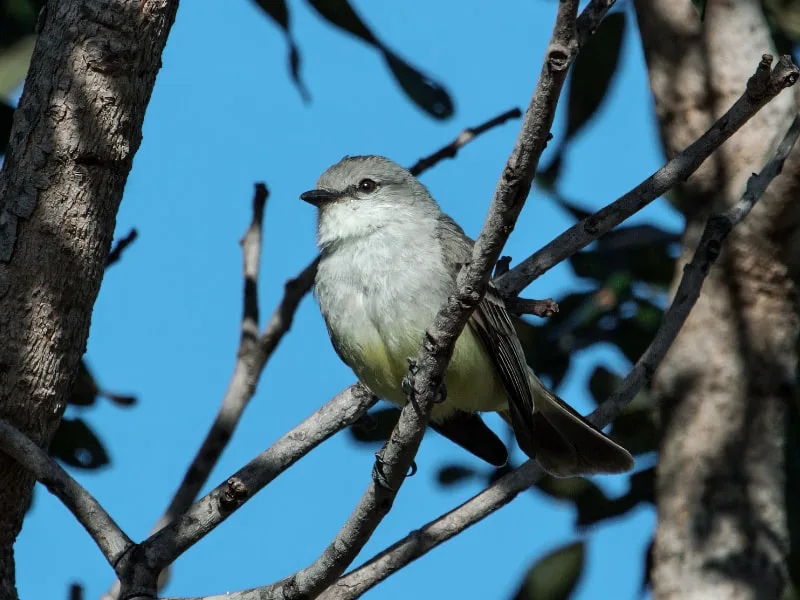
The chapada flycatcher was formally described in 2001 by Kevin J. Zimmer and colleagues after being distinguished from the Campo Suiriri (Suiriri affinis) through its unique vocalizations, notably male-female duets, as well as differences in bill morphology and tail coloration. Initially classified as Suiriri islerorum, subsequent studies revealed that it was not closely related to the Suiriri genus. In 2017, it was reclassified into a newly proposed genus, Guyramemua, with the updated binomial name Guyramemua affine.
This species inhabits cerrado and campos habitats across central Brazil, south of the Amazon River and east of the Rio Madeira, with confirmed records in states such as Mato Grosso, Pará, Goiás, Tocantins, Maranhão, and into eastern Bolivia’s Santa Cruz department. The chapada flycatcher is typically found in shrubby areas with scattered trees within grasslands, favoring elevations between 250 and 1,200 meters. It feeds on arthropods and small fruits, foraging primarily in the mid to upper levels of trees. Despite its adaptability, habitat loss due to agricultural expansion and frequent burning poses significant threats, leading to its classification as near threatened by the IUCN.
Lulu’s tody-tyrant (Poecilotriccus luluae)
- Discovered: 2001.
- Location: Northern Peru.
- Discovered by: Ned K. Johnson and R. E. Jones.
- Current status: Least concern.
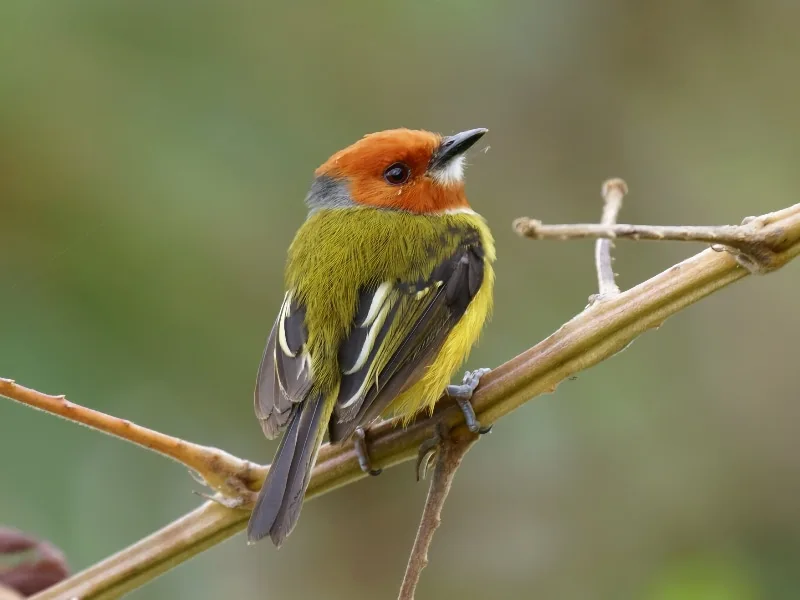
Lulu’s tody-tyrant, also known as Johnson’s tody-tyrant, was formally described in 2001 by Ned K. Johnson and R. E. Jones. It belongs to the family Tyrannidae, commonly known as tyrant flycatchers – the largest family of birds in the Americas, known for their aggressive territorial behavior. This small, colorful species stands out due to its rich chestnut-red hood (excluding a small white throat patch), gray-black hind neck band, and green upperparts with yellow-fringed wing coverts and flight feathers. Its underparts are bright yellow, and it displays a narrow white breast band beneath the hood.
Endemic to northern Peru, Lulu’s tody-tyrant is known from six localities in the northeastern Andes, including Wicsocunga near Lonya Grande, the Cordillera de Colán, and areas around Abra Patricia. It inhabits elevations between 1,800 and 2,550 meters, favoring shrubby second growth, bamboo thickets, and forest undergrowth, particularly near forest edges created by roads or logging. The species is usually encountered in pairs and forages through sally-gleaning, targeting the undersides of live leaves.
Mishana tyrannulet (Zimmerius villarejoi)
- Discovered: 2001.
- Location: Northern Peru.
- Discovered by: José Álvarez Alonso and Bret M. Whitney.
- Current status: Least concern.
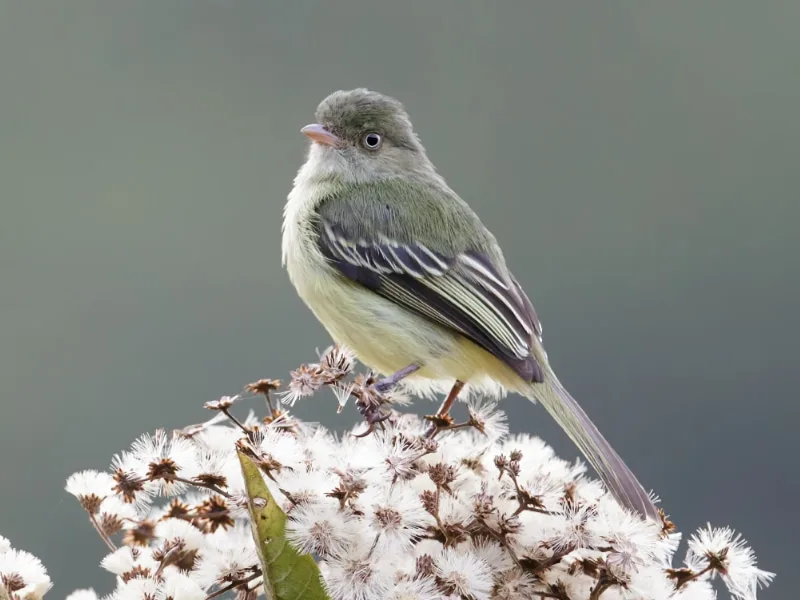
The Mishana tyrannulet was formally described in 2001 by José Álvarez Alonso and Bret M. Whitney. This small flycatcher is characterized by olive upperparts, yellowish underparts, and a pale bill. It closely resembles the red-billed tyrannulet (Zimmerius cinereicapilla) but can be distinguished by its olive (rather than gray) crown and distinct vocalizations.
Endemic to northern Peru, the Mishana tyrannulet inhabits two disjunct regions: the white-sand forests near Iquitos in Loreto Department and the Andean foothills around Moyobamba and Tarapoto in San Martín Department. It favors “varillal” habitats (poorly drained forests on white-sand soils) and is often found in the forest canopy. Its diet includes small arthropods and fruits, notably mistletoe berries. Despite its limited range, the species is currently classified as least concern, though habitat loss due to logging and agriculture remains a potential threat.
Vanuatu petrel (Pterodroma occulta)
- Discovered: 2001.
- Location: Northern Vanuatu, sightings in northeast Australia.
- Discovered by: M. J. Imber and A. J. D. Tennyson.
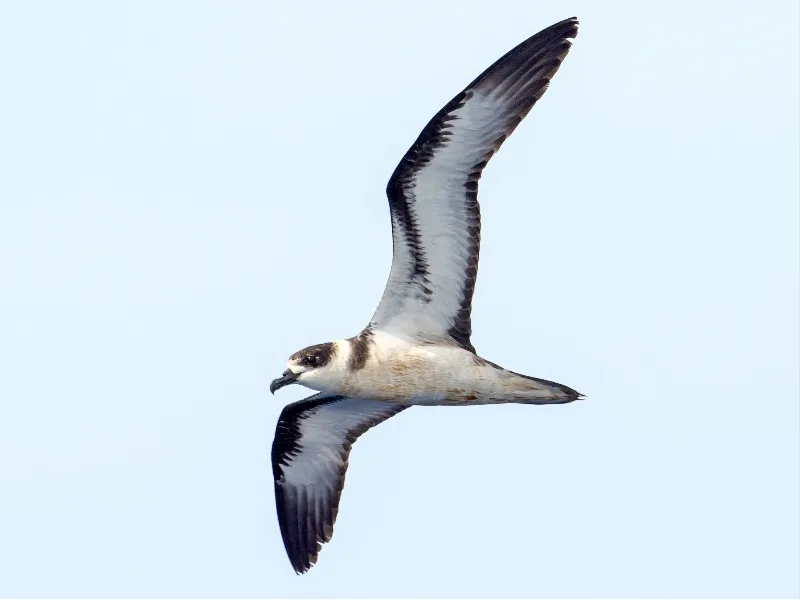
The Vanuatu petrel was first described in 2001 by M. J. Imber and A. J. D. Tennyson, based on specimens collected at sea. Initially thought to be a variant of the white-necked petrel (Pterodroma cervicalis), it was recognized as a distinct species due to its smaller size, relatively longer tail, and darker primary feathers. The species measures approximately 40 cm in length and weighs between 300-350 g. Its distinguishing features include a black cap, a white rear neck, dark grey back, wings, and tail, and a darker rump. The underparts are white with dark bases to the primary feathers, and worn individuals exhibit even darker upperparts, making field identification challenging.
The breeding grounds of the Vanuatu petrel were unknown at the time of its description but were later confirmed in 2009 on Vanua Lava in northern Vanuatu. It inhabits steep, vegetated slopes on the island and is presumed to breed in the Banks Islands or other areas of northern Vanuatu. The species has been recorded as far as northeast Australia, suggesting it is a transequatorial migrant. Despite its confirmed breeding locality, much of its life history, migratory behavior, and full distribution remain poorly understood due to its similarity to other petrel species and its elusive nature at sea.
Bukidnon woodcock (Scolopax bukidnonensis)
- Discovered: 2001.
- Location: Montane forests of Mindanao, Philippines.
- Discovered by: R. S. Kennedy, T. H. Fisher, S. C. B. Harrap, A. C. Diesmos, A. S. Manamtam.
- Current status: Least Concern.
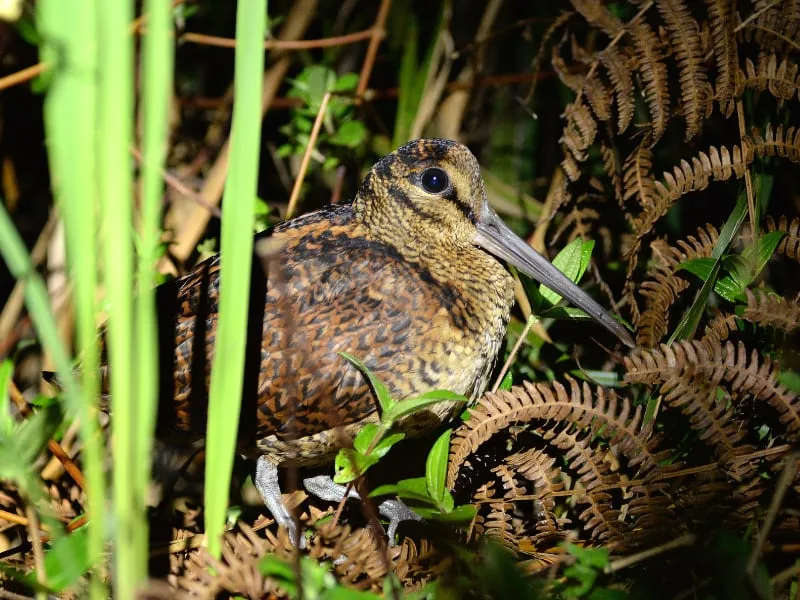
First observed in 1993, the Bukidnon woodcock was initially misidentified as the Eurasian woodcock (Scolopax rusticola) due to its similar appearance. However, in 2001, Robert S. Kennedy and his colleagues formally described it as a distinct species based on its unique vocalizations, smaller size, and subtle morphological differences. Unlike its widespread relatives, this species is endemic to the montane forests of Mindanao, where it inhabits elevations above 1,000 meters.
Primarily active at dusk and dawn, the Bukidnon woodcock performs aerial courtship displays, producing distinct calls that helped confirm its taxonomic status. Its cryptic plumage provides excellent camouflage on the forest floor, making it difficult to observe. While its population size remains uncertain, its remote habitat has contributed to its classification as Least Concern. However, continued deforestation in the Philippines poses a potential long-term threat to the species.
Chestnut-capped piha (Lipaugus weberi)
- Discovered: 2001.
- Location: Central Andes, Colombia.
- Discovered by: A. M. Cuervo, P. G. W. Salaman, T. M. Donegan, J. M. Ochoa.
- Current status: Critically Endangered.
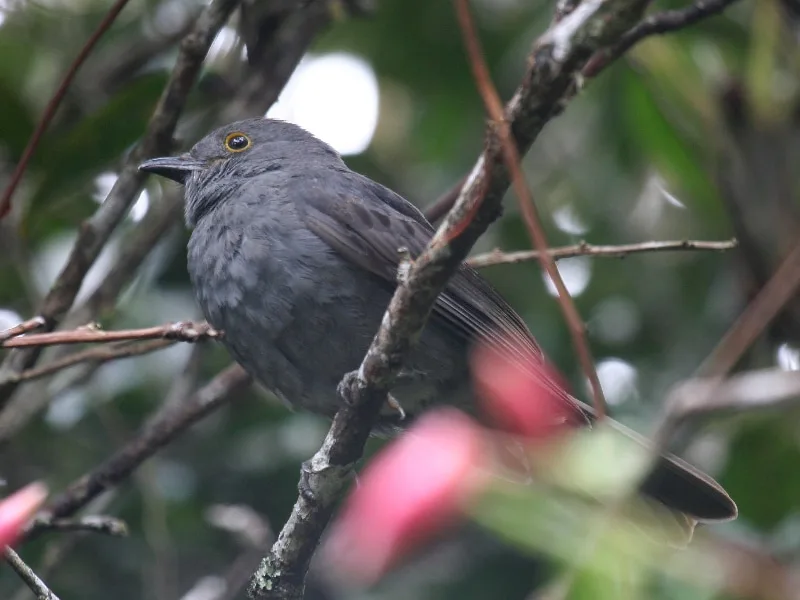
First observed in 1999, the chestnut-capped piha was formally described as a distinct species in 2001 by Andrés M. Cuervo, Paul Salaman, and their colleagues. This medium-sized bird is characterized by its dark grey plumage and a distinctive chestnut crown. Endemic to Colombia, it inhabits the humid premontane cloud forests on the northern slopes of the Central Andes, particularly within the department of Antioquia. Its loud, far-carrying calls are often the first indication of its presence in the dense forest canopy.
The chestnut-capped piha is currently classified as Critically Endangered due to its extremely limited range and ongoing habitat loss. The primary threats include deforestation for agriculture, mining, and logging, leading to significant fragmentation of its cloud forest habitat. Conservation efforts have been initiated, such as the establishment of the Chestnut-capped Piha Reserve by Fundación ProAves, aiming to protect the remaining suitable habitats and promote reforestation. Despite these efforts, continued habitat degradation poses a significant risk to the survival of this species.
Bird species discovered and recognized in 2000:
Foothill elaenia (Myiopagis olallai)
- Discovered: 2000.
- Location: Eastern slopes of the Andes in Ecuador and Peru.
- Discovered by: Paul Coopmans and Niels Krabbe.
- Current status: Least concern.

The foothill elaenia was discovered in 2000 by Paul Coopmans and Niels Krabbe in the submontane forests of eastern Ecuador and Peru. This New World flycatcher is closely related to Myiopagis caniceps and more distantly to Myiopagis gaimardii, with which it shares overlapping habitats. It was identified based on distinct vocalizations and subtle morphological differences from its closest relatives.
The species is known from four areas along the eastern Andes: the slopes of Volcán Sumaco in Napo, near Zamora, at 1,200 m above Bermejo in Sucumbíos province (Ecuador), and in Apurímac in southern Peru. It inhabits very humid to wet primary submontane forests between 890 and 1,500 meters, often found along forest edges. Rapid habitat destruction in the Andes threatens its environment, but the true extent of its range and vulnerability remains unclear.
Caatinga antwren (Radinopsyche sellowi)
- Discovered: 2000.
- Location: Northeastern Brazil.
- Discovered by: B. M. Whitney, J. F. Pacheco, D. R. C. Buzzetti, and R. Parrini.
- Current status: Least concern.
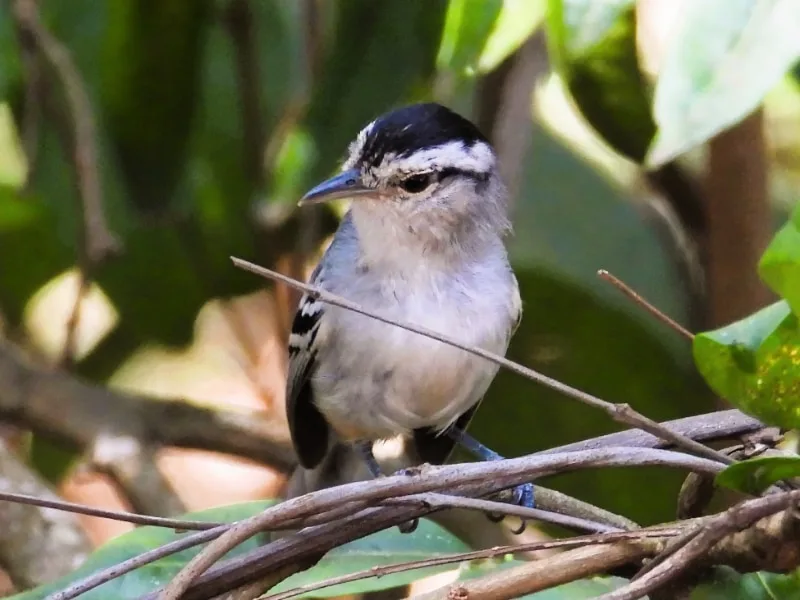
The Caatinga antwren was described as a distinct species in 2000 by Bret M. Whitney and his team after previously being grouped with Herpsilochmus pileatus (Bahia antwren). Although individuals were known for some time, their distinctiveness went unrecognized until vocal and morphological differences were thoroughly analyzed. The species is distinguished by its shorter, narrower bill, pale loral area, and a unique song – a rapid series of notes delivered at twice the pace and slightly higher pitch compared to H. pileatus.
This antwren inhabits Caatinga scrub and semideciduous woodlands up to 1,000 meters in northeastern Brazil, with recorded populations in Maranhão, Pará, Ceará, Bahia, and Minas Gerais. It primarily forages in the middle and upper levels of trees, favoring areas with papilionaceous shrubs. The species faces significant habitat pressures from agricultural expansion, grazing, and burning, exacerbated by infrastructure developments since the 1970s that have opened previously inaccessible areas for settlement and resource extraction.
Scarlet-banded barbet (Capito wallacei)
- Discovered: 2000.
- Location: Ucayali Department, Peru.
- Discovered by: J. P. O’Neill, D. F. Lane, A. W. Kratter, A. P. Capparella, and C. F. Joo.
- Current status: Vulnerable.
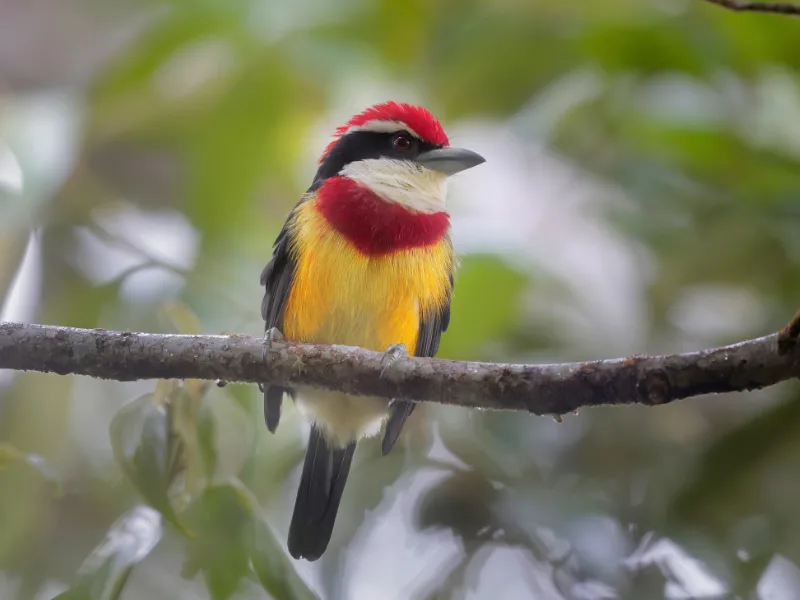
The scarlet-banded barbet was discovered in 2000 by John P. O’Neill and his team during an expedition in the eastern Andes of Peru. This striking species is known only from an isolated, unnamed ridge system east of the Cordillera Azul in the Ucayali Department, specifically from a single peak referred to as Peak 1538. Despite extensive searches in nearby areas, the species remains confined to this remote location, where up to eight individuals were recorded daily during the initial discovery.
The species inhabits cloud forests between 1,200 and 1,540 meters on a relatively flat plateau near the summit of the mountain. This habitat is rich in epiphytes, including mosses, bromeliads, and orchids, which cover the trunks and branches of short trees. The predominant vegetation includes melastomes and clusias, with a spongy forest floor covered in mosses and leaf litter. Although human habitation is minimal above 300 meters, deforestation in adjacent regions like the Cordillera Azul poses a potential threat to this highly localized species.
Gunnison sage-grouse (Centrocercus minimus)
- Discovered: 2000.
- Location: Gunnison Basin, Colorado, USA.
- Discovered by: S. T. Young, C. E. Braun, S. J. Oyler-McCance, J. W. Hupp, and T. W. Quinn.
- Current status: Endangered.
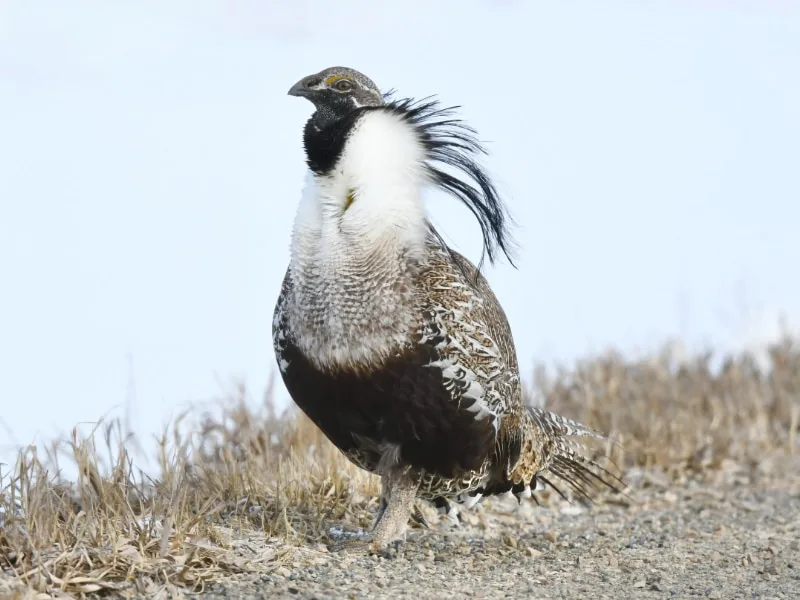
The Gunnison sage-grouse was recognized as a distinct species in 2000 by Stephen T. Young and his colleagues, differentiating it from the greater sage-grouse (Centrocercus urophasianus). It is smaller in size, with unique mating displays characterized by more elaborate strutting and distinct vocalizations. Morphological differences, such as thicker filoplumes on the neck and variations in tail feather patterns, further distinguish this species.
Endemic to the Gunnison Basin in Colorado, the species occupies sagebrush-dominated habitats at elevations between 2,200 and 2,900 meters. It relies on healthy sagebrush ecosystems for food, shelter, and nesting. The population is highly fragmented, and habitat loss due to development, agriculture, and infrastructure expansion has led to a significant decline in numbers. As of recent estimates, fewer than 5,000 individuals remain, prompting its classification as an endangered species.
Taiwan bush warbler (Locustella alishanensis)
- Discovered: 2000.
- Location: Central mountains of Taiwan.
- Discovered by: P. C. Rasmussen, P. D. Round, E. C. Dickinson, F. G. Rozendaal.
- Current status: Least Concern.
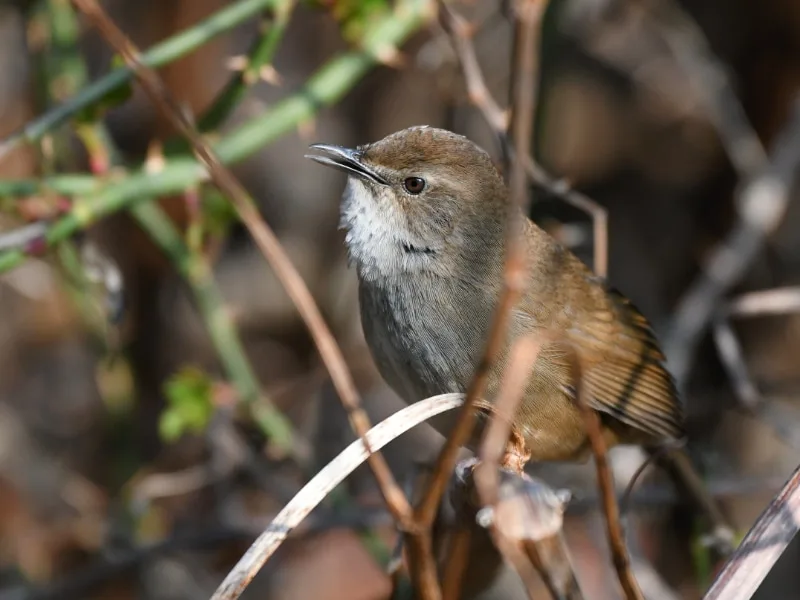
The Taiwan Bush Warbler was first collected in 1917 by Dr. Motoki and Y. Kikuchi in the Alishan region of Taiwan. Initially, this bird was thought to be a population of the russet bush warbler (Locustella mandelli). However, due to its distinctive song and subtle morphological differences, it was formally described as a separate species in 2000 by Pamela C. Rasmussen and her team.
Endemic to Taiwan’s central mountains, the Taiwan bush warbler inhabits dense bamboo thickets and edges of coniferous forests at elevations ranging from 1,200 to 3,000 meters. Despite its elusive nature, characterized by skulking behavior in dense undergrowth, its loud and repetitive song makes it identifiable during field observations. The IUCN has assessed this species as Least Concern, indicating a stable population within its habitat.
Grey-crested cacholote (Pseudoseisura unirufa)
- Discovered: 2000.
- Location: Dry forests and shrublands of South America.
- Discovered by: Kevin J. Zimmer and Andrew Whittaker.
- Current status: Least Concern (LC).
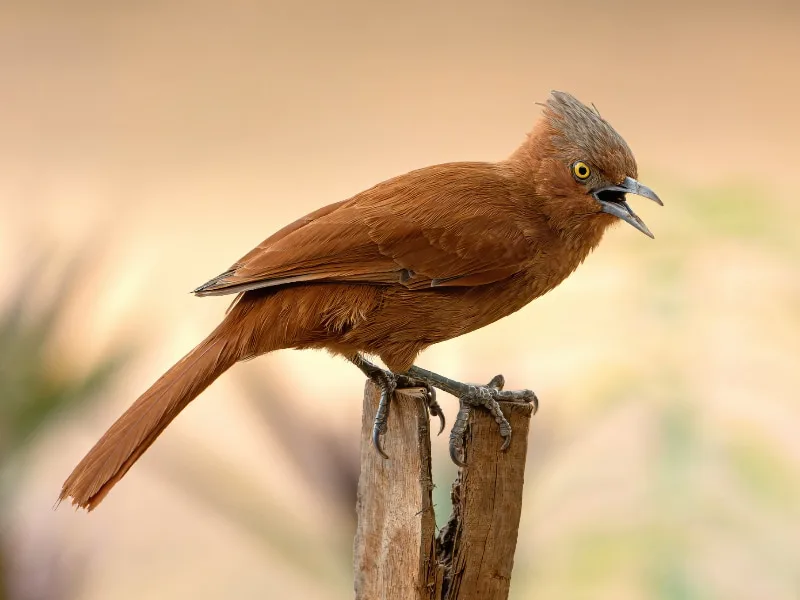
Formerly considered a subspecies of the Caatinga cacholote (Pseudoseisura cristata), the grey-crested cacholote was recognized as a distinct species in 2000 by Kevin J. Zimmer and Andrew Whittaker. This taxonomic revision was based on vocal differences, distinct plumage characteristics, and slight variations in morphology.
The species inhabits dry forests, shrublands, and thorn scrub habitats in South America, particularly in regions with scattered trees and dense undergrowth. It is known for its complex and loud vocalizations, which are often used in duets between mated pairs. Like other cacholotes, it constructs large stick nests, which it fiercely defends. Despite habitat degradation in parts of its range, the species is classified as Least Concern due to its stable population.
